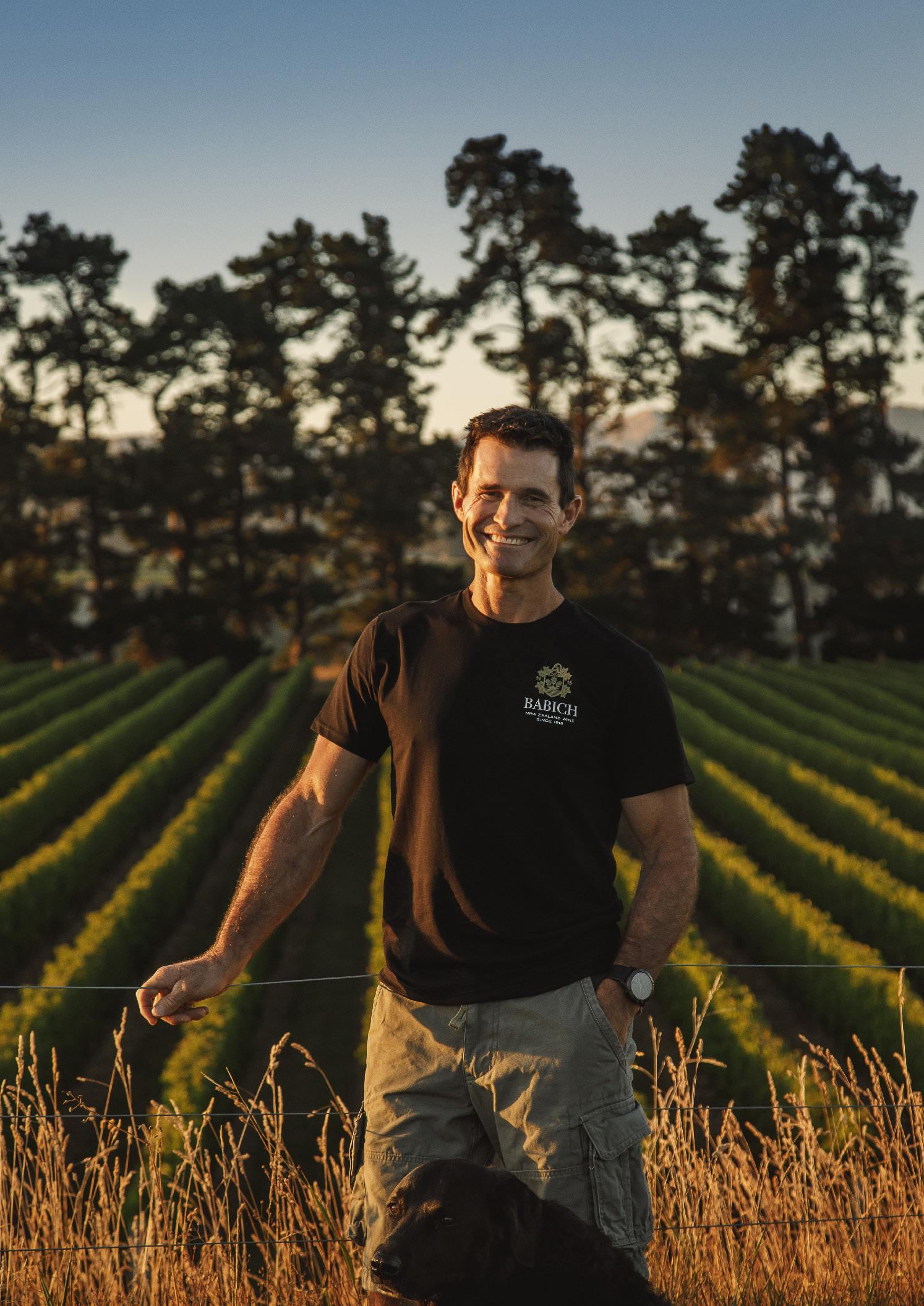
ISSUE NO. 339 / MARCH 2023 WORKFORCE PLAN
Winepress THE OFFICIAL MAGAZINE OF WINE MARLBOROUGH wine-marlborough.co.nz DE-VINE OMNISCIENCE VINTAGE UPDATE FABULOUS FESTIVAL
Photo: Jim Tannock
Riverlands, 87 Dry Hills Lane
3.2 Canopy hectares in Dry Hills
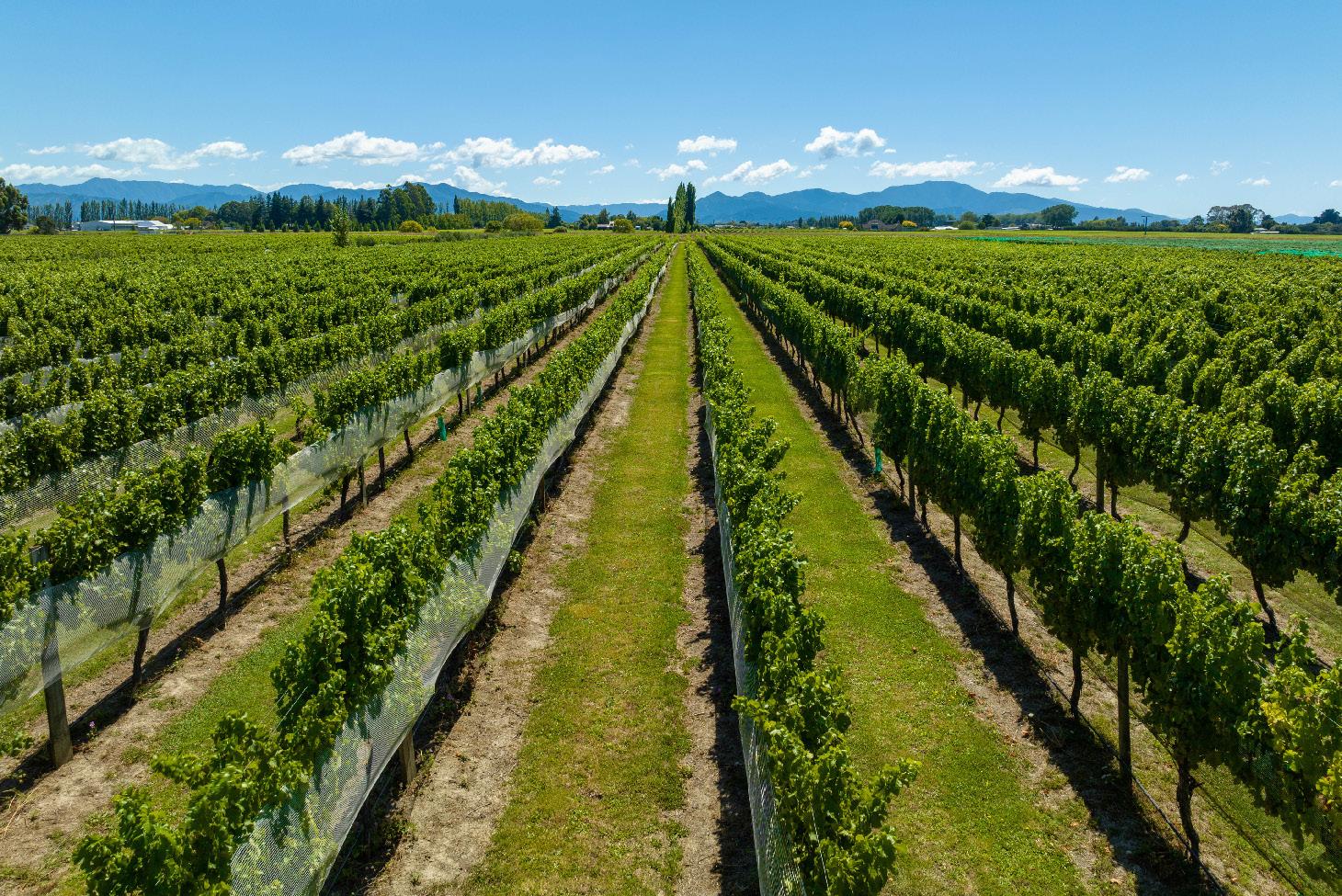
Love to own a property in the desirable Dry Hills, but require an income to help support the lifestyle? This property can offer you both which is why we are delighted to bring this exciting prospect to market. The home is constructed from permanent materials, with a floor plan spanning across some 281sqm, equipped with all of today’s modern comforts. Four spacious bedrooms, the master suite offering a walk-in-robe, ensuite and rural views with two further generous sized rooms within the home featuring built in storage and their own unique views. The fourth is located through the garage with its own access providing options to work from home, accommodate teenagers or extra guests. The main bathroom featuring underfloor heating comfortably services family and guests with a third toilet located off the garage for added convenience. The impressive open floor plan, bespoke to support the Marlborough lifestyle, delivers a natural flow between the indoor and outdoor living, with large doors opening out to the expansive deck, overlooking the vines. The kitchen, designed with entertaining in mind, showcases ample bench space, endless storage, modern appliances and most of all a functional space for the chef to entertain. Completing this home is double garaging, internally accessed providing a secure place for possessions and vehicles along with ample off-street parking. Accompanying this superb lifestyle package is 3.5 canopy hectares of Pinot Gris and Sauvignon Blanc which has been meticulously maintained, a perfect income supporting vineyard located on your doorstep. The vineyard is of a size that it could be a hands-on operation or completely hands off, the choice is yours. With vineyards of this size and in this location rarely available, and fruit in short supply, we recommend you don’t delay in registering your interest. The vendors have loved living here and now seek a new challenge within the viticulture industry. Call the exclusive listing agents Mike Poff and Charlie Fairhall Mclean for a viewing today.
bayleys.co.nz/4135456
Deadline Sale 12pm, Thu 23 March 2023 33 Seymour Street, Blenheim
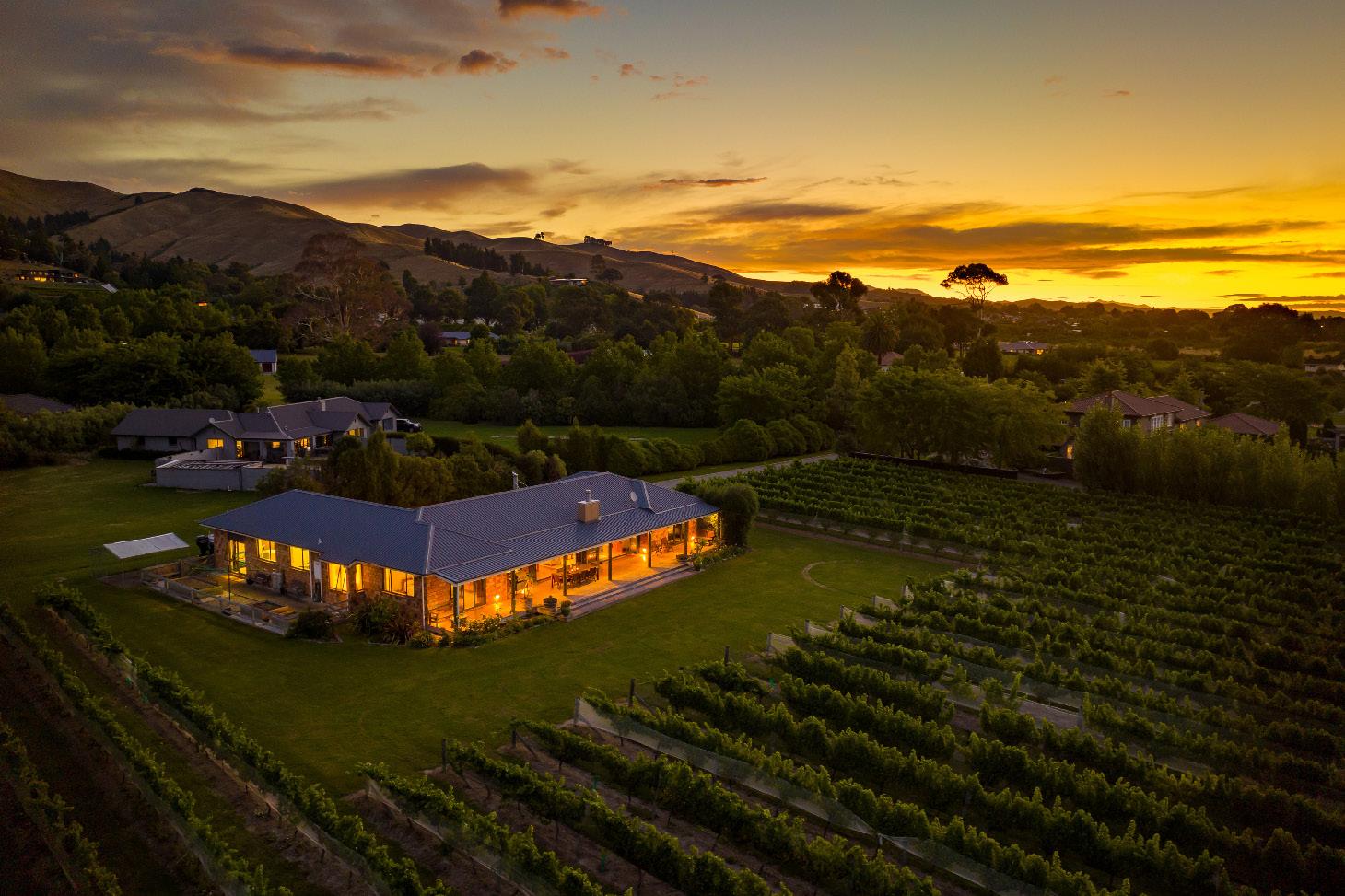
Mike Poff I 027 665 5477 mike.poff@bayleys.co.nz
BE
Charlie McLean I 027 346 1671 charlie.mclean@bayleys.co.nz
BE MARLBOROUGH LTD, BAYLEYS, LICENESED UNDER THE REA ACT 2008



MARLBOROUGH LTD, BAYLEYS, LICENESED UNDER THE REA ACT 2008
bayleys.co.nz
this issue...
10 Fabulous Festival
The 36th Marlborough Wine & Food Festival - held two years later than planned - was “world class”. Having an event in the heart of New Zealand’s largest winegrowing region is absolutely a winner,” says Tracy Johnston.

18
Wear not waste not Giesen Group is upcycling its worn-out wardrobe in a step towards circularity. “It’s amazing how many dirty old high vis are hanging around tucked away in corners,” says Renee Sturch.
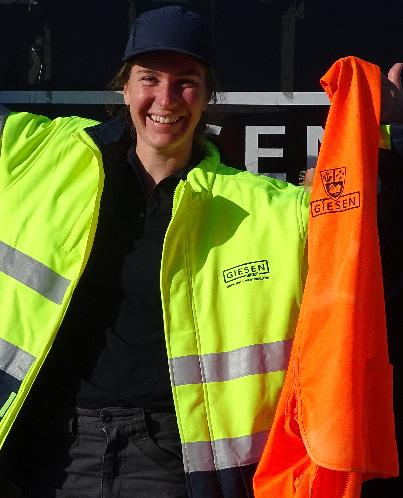
20
In the Pipeline
Continuing a series on water regulations, resource management expert Quentin Davies looks at what’s in the pipeline for Marlborough grape growers.

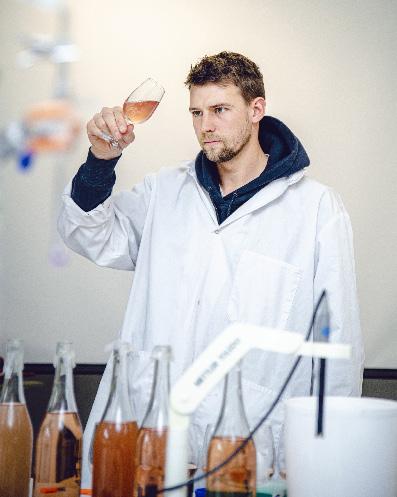
Winepress March 2023 / 1 4 22 18 REGULARS FEATURES 3 Editorial - Sophie Preece 4 Vantage Point - Mark Unwin 16 Environment AwardsCropsy Technologies 22 Generation Y-ineCameron Steel 24 Biosecurity WatchKerrie Hopkins 26 Industry News 28 Wine Happenings Cover: As vintage 2023 kicks off for some and looms for others, Babich Wines’ David Bullivant reflects on the season to date.
Jim Tannock. See page 10.
Photo
12
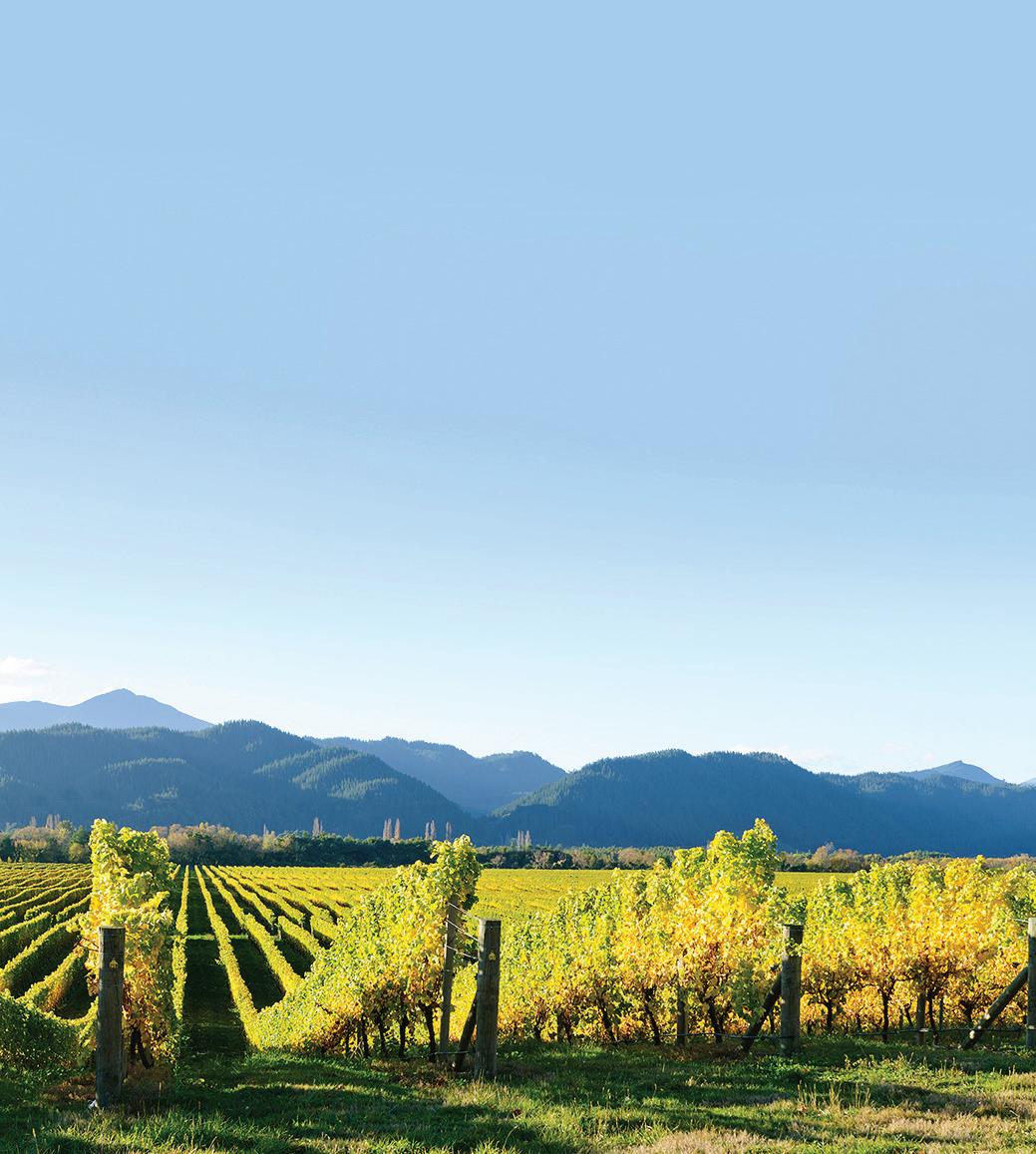

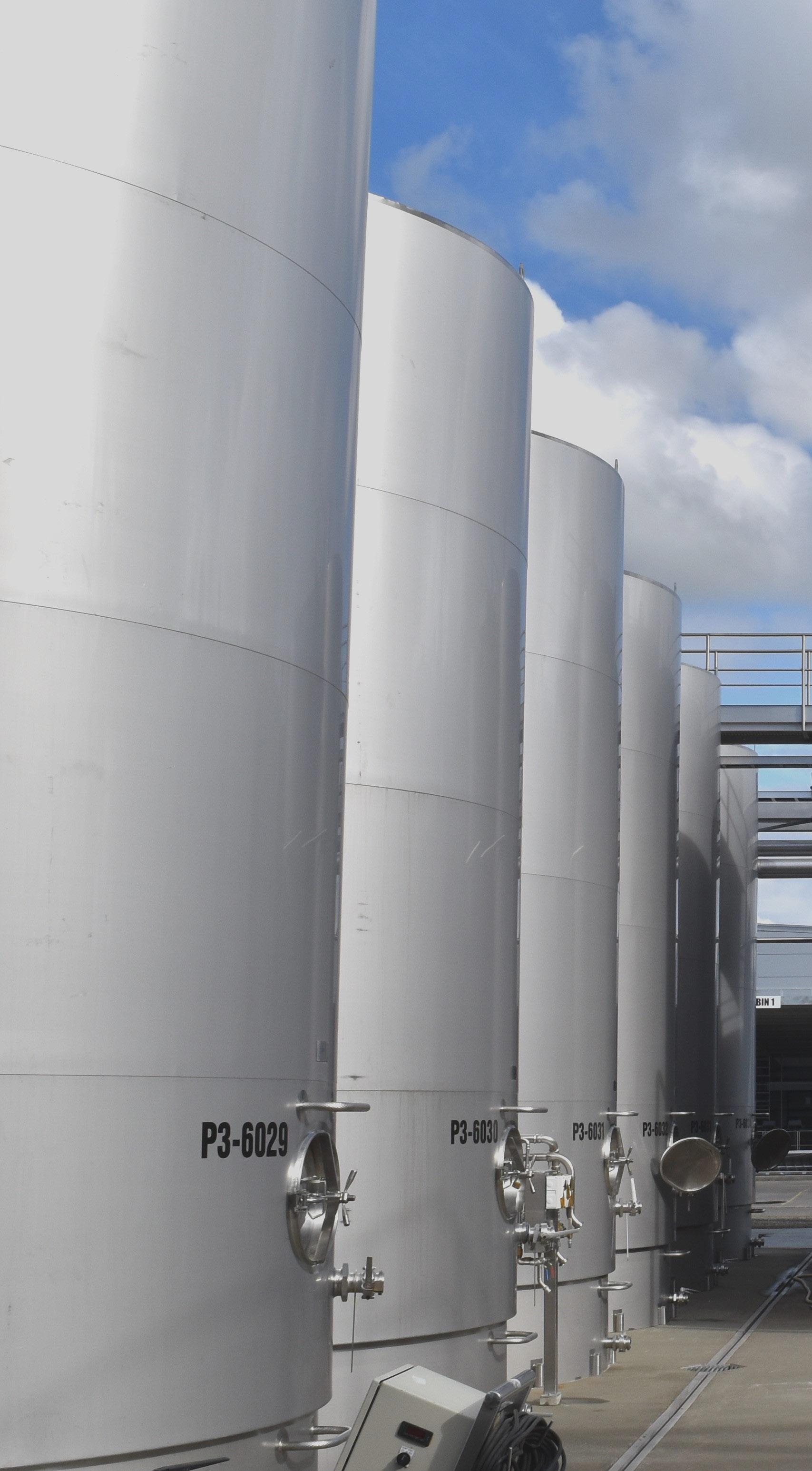

SUPPLIERS OF: n Vineyard posts & strainers n Quality timber products n Utility buildings - designed for your needs n Locally owned n Working towards the betterment of Marlborough TOP DEALS ~ TOP SERVICE 163 Hammerichs Road, Blenheim Ph 03 578 0221 sales@rapauratimber.co.nz MECHANICAL ENGINEERING WWW.PHOENIXMECHANICAL.CO.NZ 021 177 2669 Warm and Chilled Glycol Systems Design & Build Mechanical Services Heat Recovery Systems S/S Wine and Juice Lines Water Treatment and Filtration “Over 15 years experience serving the Marlborough wine industry ” PHOENIX
General Manager:
Marcus Pickens 03 577 9299 or 021 831 820 marcus@winemarlborough.nz
Editor: Sophie Preece 027 308 4455 sophie@sophiepreece.co.nz
Marketing and Communications: Sarah Linklater 021 704 733 sarah@winemarlborough.nz
Events Manager: Loren Coffey loren@winemarlborough.nz
Advocacy Manager: Nicci Armour advocacy@winemarlborough.nz

Advertising: Joanna May advertising@winemarlborough.nz
Grape Grower Directors: Andrew Nation nationa@gmail.com
Anna Laugesen anna@craiglochart.co.nz
Michiel Eradus michiel@eraduswines.co.nz
Nigel Sowman nigel@dogpoint.co.nz
Tracy Johnston tracy@dayvinleigh.co.nz
Wine Company Directors: Beth Forrest beth@forrest.co.nz
Damien Yvon damien@closhenri.com
Gus Altschwager gus@akwines.net
James Macdonald james@hunters.co.nz
Jamie Marfell Jamie.Marfell@pernod-ricard.com
Designed by: Blenheim Print Ltd 03 578 1322
Disclaimer: The views and articles that are expressed and appear in Winepress are entirely those of contributors and in no way reflect the policy of the Marlborough Winegrowers. Any advice given, implied or suggested should be considered on its merits, and no responsibility can be taken for problems arising from the use of such information.
This document is printed on an environmentally responsible paper, produced using elemental chlorine free (EFC), third party pulp from responsible sources, manufactured under the strict ISO 14001 Environmental Management System and is 100% Recyclable.
From the Editor
THERE’S NOTHING like a car upturned within a flooded vineyard, or a winery drowned in an onslaught of silt, to put things into perspective. Not to mention, of course, the stories of people cowering in ceiling cavities, rescued from rooftops, and rendered homeless by Cyclone Gabrielle in the North Island.
So while Marlborough will face a potential “botrytis timebomb” if rain continues, surely every grape grower in the province is just grateful they have not lost a vineyard to the force of nature.
Babich Wines will “walk away” from its 13-hectare Fernhill vineyard in Hawke’s Bay this season, after the entire infrastructure was flattened by the flood. They’ll redevelop in due course, says the company’s Marlborough area vineyard manager David Bullivant, speaking in this edition about Marlborough’s
2023 harvest prospects. “I have an enormous amount of empathy for friends and work colleagues in Gisborne and Hawke’s Bay who have watched 12 months - or in some cases a lifetime - of hard work be destroyed in Cyclone Gabrielle,” he says. “Let alone the mental anguish of cleaning up their vineyards and property over the next weeks, months, years.”
When it comes to Marlborough’s 2023 vintage, he’s “cautiously optimistic”, hoping for one of the best harvests the region has seen in several years, in terms of grape and wine quality and quantity. “However there’s still some water to flow under the bridge,” he adds on an inclement day in late February, hoping the forecast high on the horizon delivers great grape conditions. Even then, it’s been a season to test the mettle of viticulturists. “Anyone can bluff their way through in a very benign, dry, warm season,” says David. “But when you get something more challenging, those people who are a bit more diligent shine through.”
Water is a big topic in the edition, including the second part of a series by resource management expert Quentin Davies, a partner at Gascoigne Wicks, who explains what’s coming down the pipeline for Marlborough winegrowers.
SOPHIE PREECE
Winepress March 2023 / 3
Surely every grape grower in the province is just grateful they have not lost a vineyard to the force of nature.
Vantage Point
The wellbeing economy
MARK UNWIN
WHETHER IT’S a pandemic, wild weather or a labour skills shortage, the opportunities and challenges of our export wine industry are complex and ever evolving. From our tiny corner of the world, Marlborough’s ability to respond to global markets will lie in our own resilience.
Remember the start of the Covid-19 pandemic, as grapes began to roll into the wineries? As labour tightened and borders closed, 2020 was a vintage to remember for grape quality. And as lockdowns dominoed across the globe, New Zealand wine exports soared above $2 billion. It not only highlights the unpredictability and volatility of our global markets, but that the health of our economy here in Marlborough is highly dependent on our ability to quickly respond—namely the health of our people and our natural environment. And, if you think technology will change this, then keep reading.
Marlborough’s Economic Wellbeing Strategy

In late 2022, Marlborough District Council (MDC) launched a first-of-its-kind Economic Wellbeing Strategy for the region. This 10-year outlook was really an audit of our region’s current strengths and biggest worries for the future. It came about through several industry workshops (including over 1,000 sticky notes), as well as meeting with the region’s youth, iwi and angel investors. The end result was a plan to build on our region’s strengths and work on the gaps where our biggest risks lie. For the wine industry, we identified 21 things we can do to collaborate, build resilience and capitalise on opportunities—together.
Wine’s contribution to the Marlborough economy has grown by 300% since 2000 and is still growing. This is why collaboration across all stakeholders is vitally important. There are environmental impacts, housing impacts, skills gaps and labour shortages—all as the wine industry’s rapid growth outpaces labour, water, roading and housing supply.
So how does this plan for economic wellbeing translate to action? It covers topics from increasing accommodation for seasonal workers to reducing the industry’s waste streams. Keep reading for just a couple of examples of the plan in action.
Workforce Attraction Campaign
The wine industry employs 2,900 people and makes up about 20% of Marlborough’s gross domestic product. The ability of growers to achieve their intended planting of 5,150 hectares by 2024/25 will depend on their ability to secure land, grapevine cuttings, labour, accommodation for the new workforce and the required consents. In terms of workforce, this growth would lead to an estimated 17% increase in jobs for the industry.
So this year council has joined forces with other agencies to help spread the word about employment opportunities in the region to help industries fill their talent gaps. Council’s Economic Development team, along with the Marlborough Chamber of Commerce and the Ministry of Social Development, launched a skills attraction campaign to support Marlborough businesses to fulfil $70,000-plus job vacancies and bring new talent to our region.
From winery engineers to data analysts and operations managers, the wine industry and support businesses have listed several roles the region needs to fill for annual salaries over $70,000. This attraction campaign has been aimed at holidaymakers in Marlborough over the summer season. Check out the jobs available at weloveithere.nz, and send the link to someone you might know who’s considering a move to Marlborough. And stay tuned for our next step, a virtual reality ride from grape to bottle to show your potential employees what it’s like and the opportunities available in the region.
Connecting agritech to the region
There is no doubt that Marlborough’s skilled labour shortage, coupled with continued growth in the wine
4 / Winepress March 2023 PROTECT
The Marlborough District Council’s Economic Development team, Marlborough Chamber of Commerce, and Ministry of Social Development launched a skills attraction campaign to draw new talent to the region.
Carina Dick and Bec Ryan get framed at the Marlborough Wine & Food Festival

industry, will be important for innovation and automation. As companies look to depend less on labour and more on machines to carry out manual tasks, the nature of work and skills required will evolve with innovation. For example, increased automation might need fewer workers for manual tasks but more workers who understand coding and how to fix the machines. Simply put, the agritech sector is and will be very important for Marlborough and the skills required for the region to thrive.
In partnership with industry sectors and central government, we have presented a business case for a Tech & Innovation Lab in Blenheim, to give start-ups, the innovation community, and activation-programmes
Cyclone Clean Up
a ‘home’. We have also started the discussion with local education providers about building skills in coding and technology right here at home.
Marlborough is home to 1% of New Zealand’s population, but that’s not stopping us from pulling all levers at the national level to attract and connect the technology sector to our region. From winegrowing to aquaculture and forestry, our primary industries are poised for growth, and the time is now to innovate and stay competitive in global markets.
What’s next?
The challenges faced by the wine industry can be abrupt and unanticipated, such as a pandemic, or they can be slowmoving and in plain sight, such as climate change. One thing is clear, and that’s our wellbeing as a region depends on our ability to respond to change.
In partnership with Wine Marlborough, we have started a Smart + Connected industry group to see what we can collectively do with organic waste in the region. Get involved by contacting us or Wine Marlborough.
We hope that you will join us in the region’s first plan that’s looking beyond growing and surviving—to looking at what it will take to sustainably thrive into the future. Mark Unwin is economic development portfolio manager with the MDC Economic Development team. Contact him at mark.unwin@marlborough.govt.nz
Winegrowers struck by Cyclone Gabrielle have shown great “strength and determination” in the wake of the flooding, says New Zealand Winegrowers (NZW) chief executive Philip Gregan. But while many have moved rapidly from clean-up to harvest, some “devastated winegrowers” suffered huge damage to their vineyards and wineries, and need help to begin the recovery and rehabilitation process. “Those affected have a long road ahead of them to assess the damage, undertake the clean-up and consider their future.” Recovery funding announced by government was a good start “and future financial relief that is expected to be announced in due course will be appreciated”, Phillip said in late February, as New Zealand Winegrowers, the regional winegrower associations, and government agencies coordinated to support impacted growers and help them access resources to ensure the future viability of their vineyards.
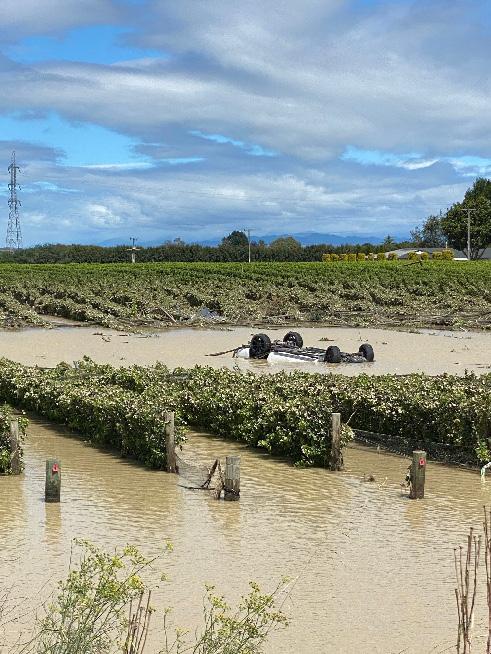
He noted that a large number of vineyards in both regions had not been as significantly impacted by the major flooding event, “and these winegrowers are beginning to harvest their crop, with many producers still feeling positive and looking forward to a high-quality vintage”.
Meanwhile, the industry has come together to help those members most in need, and many have contributed financially to help the wine community with the recovery and rehabilitation process. The Hawke’s Bay Winegrowers Charitable Trust has set up a Cyclone Gabrielle Relief Fund, with 100% of donations to go to those most in need in the Hawke’s Bay Wine community. The Hawke’s Bay Winegrowers Charitable Trust will match donations up to $30,000. To find out more about donating to the Hawke’s Bay and Gisborne wine communities go to: nzwine.com/en/events/cyclone-gabrielle-relief-funds/
Winepress March 2023 / 5 PROTECT
Photo by Sarah White
Table 1: Blenheim Weather Data – February 2023
minimum temperatures were well above average. The above average minimum temperatures were undoubtedly associated with the above average cloud cover.
The first week of February was exceptionally warm. In contrast the second and fourth weeks of February were below average and the mean temperatures during these weeks were 5.4°C and 6.5°C cooler respectively than the first week.
Summer temperatures
At the beginning of December 2022
¹GDD’s Max/Min are calculated from absolute daily maximum and minimum temperatures
²GDD’s Mean are calculated from average hourly temperatures
Temperature

The February 2023 mean temperature of 18.8°C was 0.9°C above the long-term average (LTA) temperature for February (1986-2022). This was a lot warmer than in the previous two years. However, while the mean temperature was 0.9°C above the LTA, the mean maximum temperature was only 0.2°C above the LTA, whereas the mean minimum temperature was 1.6°C above the LTA; i.e. the daytime maximum temperatures were close to average but the overnight
NIWA predicted for Marlborough that there was a 55% chance of above average temperature, 40% chance of average temperature and only a 5% chance of below average temperature for the full 3-month period from December 2022 to February 2023; i.e. they were fairly certain that Marlborough would experience a warmer than average summer. The average temperature for the three summer months of 17.9°C was 0.2°C above the LTA; so technically NIWA’s prediction was correct. However, it didn’t feel like a warm summer and the first two months were cooler than average. December recorded a mean temperature slightly below average (-0.1°C), January slightly below average (-0.2°C), and February well above average (+0.9°C). Essentially the very warm first week of February dragged both the February mean and the summer mean temperatures up above
Table 2: Weekly temperatures, rainfall, sunshine and wind-run during February 2023
6 / Winepress March 2023
February Feb 2023 Feb Period Feb 2023 compared to LTA LTA of LTA 2022 GDD’s for: Month - Max/Min¹ 245.7 % 226.3 (1996-2022) 204.5 Month – Mean² 241.0 % 218.7 (1996-2022) 197.6 Growing Degree Days Total Jul 22–Feb 23 – Max/Min¹ 1124.4 % 1041.3 (1996-2022) 1135.8 Jul 22–Feb 23 – Mean² 1144.7 % 1073.1 (1996-2022) 1151.0 Mean Maximum (°C) 23.4 +0.2°C 23.2 (1986-2022) 21.2 Mean Minimum (°C) 14.1 +1.6°C 12.5 (1986-2022) 13.4 Mean Temp (°C) 18.8 +0.9°C 17.9 (1986-2022) 17.3 Grass Frosts (<= -1.0°C) Equal 0.00 (1986-2022) 0 Air Frosts (0.0°C) Equal 0.00 (1986-2022) 0 Sunshine hours 193.9 84% 229.5 (1986-2022) 156.4 Sunshine hours – lowest 133.6 2012 Sunshine hours – highest 298 1968 Sunshine hours total – 2023 405.6 82% 495.1 (1986-2022) 470.2 Rainfall (mm) 40.2 82% 48.8 (1986-2022) 153.4 Rainfall (mm) – lowest 1 1973 & 1983 Rainfall (mm) – highest 181.4 2018 Rainfall total (mm) – 2023 100.6 111% 90.3 (1986-2022) 166.0 Evapotranspiration – mm 111.0 97% 114.4 (1996-2022) 86.6 Avg. Daily Windrun (km) 212.6 86% 246.6 (1996-2022) 180.1 Mean soil temp – 10cm 18.7 +0.4°C 18.3 (1986-2022) 17.8 Mean soil temp – 30cm 20.5 -0.1°C 20.6 (1986-2022) 19.5
Mean Mean max Mean Min Rainfall Sunshine Wind-run (°C) (°C) (°C) (mm) (hours) (km) 1st - 7th 22.9 (+5.0) 27.7 (+4.5) 18.0 (+5.5) 1.6 52.6 263.0 8th - 14th 17.5 (-0.4) 21.4 (-1.8) 13.6 (+1.1) 12.6 49.0 228.9 15th - 21st 18.3 (+0.4) 24.1 (+0.9) 12.5 (=) 8.0 60.2 178.1 22nd - 28th 16.4 (-1.5) 20.4 (-2.8) 12.4 (-0.1) 18.0 32.2 180.3 1st – 28th Feb 18.8 (+0.9°C) 14.1 40.2 193.9 212.6 86% 23.4 (+0.2 ) (+1.6°C) 82% 84% LTA 1986-2022 17.9 23.2 12.5 48.8 229.5 246.6
average. It is interesting what a difference one hot week made to the overall mean summer temperature.
Table 3: Mean temperatures over the 6 summers from 2017-18 to 2022-23
Sunshine
February recorded 193.9 hours sunshine, 84% of the LTA (1986-2022). While this total was well below average it was nowhere near as low as in February 2022, when only 157.3 hours sunshine, or 69% of the LTA was recorded.
Table 4: Sunshine hours over the 6 summers from 2017-18 to 2022-23
All 3-months of the 2022-23 summer recorded below average sunshine hours. With a total of 639.8 hours, the summer sunshine total for 2022-23 is ranked 88th out of the 93 years on record, from 1930-31 to 2022-23; i.e. only 5 summers over the last 93 years have recorded less sunshine.
Rainfall
The February rainfall total of 40.2 mm was 82% of the LTA (1986-2022).
Table 5: Rainfall over the 6 summers from 2017-18 to 2022-23
Total summer rainfall in 2023-23 of 149.4 mm was 108% of the LTA total. While it may have felt like a wet summer, rainfall was close to average. January was the only summer month to record above average rainfall. Blenheim (Marlborough) escaped the high rainfall that so much of the North Island received in January and February 2023. In contrast the previous summer of 2021-22 was a lot wetter in December 2021 and February 2022.
Wind Run
Average daily wind run for February 2023 was 212.6 km, 86% of the LTA (1996-2022).
Shallow Soil Moisture
Average shallow soil moisture (5–35 cm depth) at the Grovetown Park weather station for February was 20.6%. This is slightly above the LTA of 18.9%.
Potential Evapotranspiration
Potential evapotranspiration for February 2023 was 111.0 mm, 97% of February’s LTA of 114.4 mm.
Potential Water Deficit
Potential water deficit (Table 7) is the difference between monthly rainfall received (Table 5) and potential monthly evapotranspiration lost (Table 6). Potential water deficit for February 2023 was -70.8 mm, 97% of the LTA.
Potential water deficit for the three summer months December 2022 – February 2023 was -201.1 mm, 74% of the LTA.
Winepress March 2023 / 7
Long-term 2017-18 2018-19 2019-20 2020-21 2021-22 2022-23 Average Mean Mean Mean Mean Mean Mean °C °C °C °C °C °C °C December 16.9 18.7 17.4 16.7 16.7 18.6 16.8 January 18.2 20.7 20.7 17.5 18.4 18.3 18.0 February 17.9 18.8 18.9 19.2 17.5 17.3 18.8 Mean 17.7 19.4 19.0 1.8 17.5 18.1 17.9 +/-LTA +1.8 +1.4 +0.17 -0.2 +0.4 +0.2
Long-term 2017-18 2018-19 2019-20 2020-21 2021-22 2022-23 Average mm mm mm mm mm mm December 48.4 21.6 53.6 91.2 22.8 85.8 48.8 January 41.4 80.4 3.8 0.2 7.8 12.6 60.4 February 48.8 181.4 8.0 8.6 22.8 153.4 40.2 Total 138.9 mm 283.4 mm 65.4 mm 100.0 mm 53.4 mm 251.8 mm 149.4 mm 204% 47% 72% 38% 181% 108%
Long-term 2017-18 2018-19 2019-20 2020-21 2021-22 2022-23 Average hours hours hours hours hours hours December 248.9 319.1 213.2 272.6 255.4 201.5 234.2 January 265.6 243.6 317.9 245.0 309.0 313.8 211.7 February 229.5 226.4 289.4 270.9 263.9 156.4 193.9 Total 744.0 789.1 820.5 788.5 282.3 671.7 639.8 106% 110% 106% 111% 90% 86%
Table 6: Potential evapotranspiration over the 6 summers from 2017-18 to 2022-23
Table 7: Potential Water Deficit over the 6 summers from 2017-18 to 2022-23
Figure 1: Seasonal water balance for Blenheim: difference between 3-month totals of rainfall and potential evapotranspiration
Figure 1 displays the seasonal water balance over the four most recent seasons. This graph plots the potential water deficit on a 3-month daily basis. The black line is the LTA. As explained on previous occasions Blenheim normally only experiences a water surplus for about 4-months from mid-June until early October. With very high rainfall (for Blenheim) in July and August 2022 the water balance rose to its highest ever positive value of 328.2 mm on 25 August 2022. This was 253.7 mm above the LTA. However, with below average rainfall in September and October 2022 the water balance line dropped rapidly. Close to average rainfall and below average evapotranspiration over the 2022-23 summer has kept the water balance line slightly higher than average.
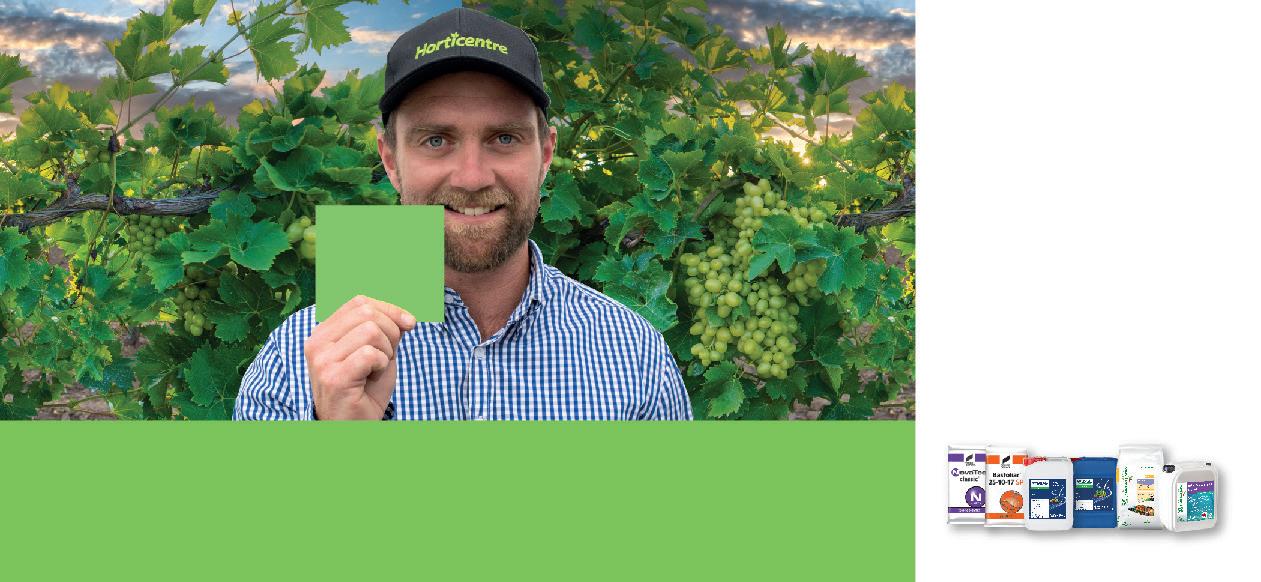
8 / Winepress March 2023
-450 -400 -350 -300 -250 -200 -150 -100 -50 0 50 100 150 200 250 300 350 1-Jul 1-Aug 1-Sep 1-Oct 1-Nov 1-Dec 1-Jan 1-Feb 1-Mar 1-Apr 1-May 1-Jun W a t e r b a l a n c e ( m m ) Average 2019/2020 2020/2021 2021/2022 2022/2023 Accumulated potential w ater surplus Accumulated potential w ater deficit
Rob Agnew - Plant & Food Research / Marlborough Research Centre
Long-term 2017-18 2018-19 2019-20 2020-21 2021-22 2022-23 Average mm mm mm mm mm mm December 139.4 177.8 114.9 140.1 143.2 135.1 118.2 January 144.9 135.6 186.9 133.9 172.3 152.5 121.3 February 114.4 122.4 151.0 140.3 123.3 86.6 111.0 Total 398.7 mm 435.8 mm 452.8 mm 414.3 mm 428.8 mm 374.2 mm 350.5 mm 109% 114% 104% 110% 94% 88%
Long-term 2017-18 2018-19 2019-20 2020-21 2021-22 2022-23 Average mm mm mm mm mm mm December -91.0 -156.2 -61.3 -48.9 -120.4 -49.3 -69.4 January -106.6 -55.2 -183.1 -133.7 -164.5 -139.9 -60.9 February -73.0 +59.0 -143.0 -131.7 -100.5 +66.8 -70.8 Total -270.6 mm -152.4 mm -387.4 mm -314.3 mm -385.4 mm -122.4 mm -201.1 mm 56% 143% 116% 142% 45% 74%
Talent Quest
Holistic approach to wine workforce planning

SOPHIE PREECE
ENSURING THE growth and sustainability of Marlborough’s wine workforce requires a deep understanding of industry requirements, now and into the future.
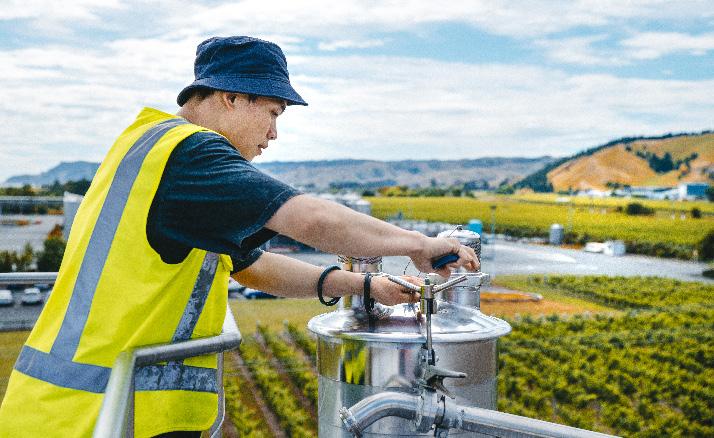
That’s at the core of the foundation workforce plan developed by a diverse industry stakeholder group, says Wine Marlborough advocacy manager Nicci Armour. Over the next six months, high resolution data collection will be undertaken to inform the plan, offering insights into the current and future skills needed across all aspects of the sector – from vines, wines and wine science to human resources, sales and supply lines.
The plan will analyse current gaps and future projections, in order to keep pace with the growing size and maturity of Marlborough’s wine industry, New Zealand’s ageing workforce, and a global labour-shortage anticipated to last a decade, says Nicci. “If we don’t do this forward planning we are going to miss out on good people - the people we need to help drive business growth, success and innovation.”
The workforce plan will look at all layers of the workforce, with seasonal, medium-term and long-term requirements assessed across a broad spectrum of industry sectors, Nicci says. The region has already experienced constraints in terms of finding the labour it needs, particularly for seasonal surges in work, “but the pressure
is now on permanent staff as much as anything”, she adds, reiterating that skills gaps and labour shortages are affecting vineyard and wine production, but also bottling, transport, and other support services.
Marlborough’s wine sector workforce plan is aligned to Marlborough’s Regional Workforce Plan and the work of the Marlborough Regional Skills Leadership Group, as well as relationships with newer organisations, such as Muka Tangata, the Food and Fibre Workforce Development Council, and the Food and Fibre Centre of Vocational Excellence.
The plan will discard the ‘old story’ still told in the wine industry, where opportunities lie predominantly in viticulture and winemaking. The truth lies instead in a broad array of roles, and career pathways that can shift up and across fields, Nicci says. The stakeholder group has representatives from human resources, advocacy, contracting, education, and sales, reflecting some of the diverse opportunities available. “We need to understand that as an industry and get clear on it,” Nicci says. “Everyone has a sense of it, but we’re not telling that story very well.”
Less linear pathways are the future of work, she adds. “The generations behind us are looking to be employed for their skills, not for a set role they will stick to for the next 20 or 30 years.”
Winepress March 2023 / 9 GROW
CENTA-GRO COMPOST Post-harvest is
to
growing season! How we can help! - Centa-gro - Transport
Spreaders
Loaders
021 228 2774
An image from a Marlborough wine attraction campaign. Photo Richard Briggs
an excellent time
apply nutritious compost under-vine for the spring
-
-
Dillon:
dillon@centaland.co.nz
MARLBOROUGH'S WEATHER has been neither dreadfully bad nor outstandingly good for grape growing this season, says Babich's area viticultural manager David Bullivant. But he’s “cautiously optimistic” that vintage 2023 could produce one of Marlborough’s best harvests in several years, in terms of grape and wine quality and quantity. “There is still some water to flow under the bridge,” he says in late February, with cool rainfall still wet on the ground, but an expected high looming on the horizon. “That will certainly be helpful for us.”
The “mediocre” weather conditions of spring and summer included a short but intense series of frost events from October 6 to October 8, and a wetter than average November and January, up 46% and 45% on the long-term average respectively. That rainfall fed into the 12 Bacchus botrytis infection periods recorded from November 30 through to January 11, well up on the four to five Marlborough would typically expect, says David. “So we could have a botrytis time bomb waiting to explode if conditions become wet.”
The weather over the next six weeks will “sort the wheat from the chaff”, he adds. “Vineyards that have applied spray products at the most suitable phenological stage, but more importantly have achieved good spray coverage, will be rewarded if we get inclement weather.” Anyone can bluff their way through in a very benign dry and warm season, David says. “But when you get something a bit more challenging, those people who are a bit more diligent shine through.”
Babich is expecting a crop that is similar to or better than their long-term average, led by hearty Sauvignon Blanc counts, while Pinot Noir and Chardonnay are less fruitful.

Vintage 2023
Challenging season with plenty of potential
“Sauvignon Blanc is the variety that is most important and it’s looking good,” David says, noting that there are “mixed expectations” across the industry for 2023 yields, with the Plant & Food Research forecast model predicting a lower yield, while a number of wineries are expecting a normal harvest, or slightly above. Pinot Noir is sitting at “a nice balanced crop level” for Babich, while Chardonnay is looking light, and is the most susceptible to Powdery Mildew, “which has been an issue this season”. He reiterates that those with the right spray programmes and coverage at the right phenological stage should be okay, “but it’s more at risk than other varieties”. The company’s harvest will start later than in recent years, with a kick off closer to the long-term average, including a Sauvignon Blanc start day of March 20 or 24.
David has welcomed a return to normal for the Recognised Seasonal Employer (RSE) scheme, “after a harrowing experience during the Covid pandemic”. Vineyards he has encountered completed winter pruning early, and summer canopy management operations on time. “I am sure the Covid border restrictions made all of usgrowers and RSE workers alike - appreciate the importance of the partnership we have developed over the past decade,” he adds, “We must continue to treat each other with respect and integrity.”
However, while labour supply has improved, the restrictions in global freight services caused by Covid-19
10 / Winepress March 2023 GROW
SOPHIE PREECE
“When you get something a bit more challenging, those people who are a bit more diligent shine through.”
David Bullivant
Photo Jim Tannock
have been exacerbated by Cook Strait ferry cancellations, so that sending wine to customers overseas is slow, says David. “Most wineries will be storing more wine than usual from Vintage 22 because of this bottle neck.” That could make life “challenging” for wineries when it comes to capacity this vintage and has also complicated seasonal vineyard work, with “frustrating delays” getting tractors delivered before the season’s work is completed, he says.
Despite those challenges, the impact of Cyclone Gabrielle makes the “mediocre” season something to be grateful for, David says. “I have an enormous amount of empathy for friends and work colleagues in Gisborne and Hawke’s Bay who have watched 12 months, or in some cases a lifetime, of hard work be destroyed in Cyclone Gabrielle.”
Saint Clair Family Estate’s Jarrah Prior says Marlborough growers will be slow to complain, “considering
the hardships other regions are currently going through”. It has been an “interesting season”, with periods of higher humidity and above-average levels of vigour in the vineyards, requiring a few extra rounds of trimming and plucking, “but all in all we are happy with how the season is shaping up”, he says. “We are expecting quite a spread out harvest this season, in contrast to some of the condensed harvests in previous years. This allows us to really take our time, drilling down on taste and optimal flavour ripeness when making the final harvesting decision.”
The company kicked off its harvest on February 22 with sparkling wine. As per company tradition, the first fruit of the season was welcomed with the ringing of a bell and glass of bubbles, which staff loved, says marketing manager Julie Ibbotson.

Supply lines challenges continue, with ongoing price increases from suppliers, long lead times and shipping delays, which has become the “new norm”, she says. “We have begun to simply expect challenges with getting wine out of the country.”
Meanwhile, Saint Clair is excited to have many returnee cellar hands here for vintage. “It is nice to have New Zealand borders open again and a decrease in any Covid restrictions is welcomed,” Julie says. However, they still struggle to find enough hospitality staff for the Saint Clair Vineyard Kitchen, and have limited summer opening to five days a week.
28 TYNTESFIELD ROAD, WAIHOPAI VALLEY

With irrigation water available and vineyard potential, this 8ha property with attractive home and gardens is nowadays unique. A den could be a third bedroom in the main house while a separate annex offers two-bedroom accommodation for family, friends and additional income from paying guests.
VIEW: nzsothbysrealty.com/CCR10459

DEADLINE SALE: Closes 12 noon 13th April 2023
TIM CRAWFORD: 021 704 833 | tim.crawford@nzsir.com
MICHAL WELLS: 021 420 428 | michal.wells@nzsir.com
Winepress March 2023 / 11 GROW
“We have begun to simply expect challenges with getting wine out of the country."
Julie Ibbotson
Each office is independently owned and operated. Corn Corp Realty Limited (licensed under the REAA 2008) MREIN
Sparkling start to Saint Clair’s 2023 vintage
Wine & Food
Marlborough’s iconic festival worth the wait

THE 2023 Marlborough Wine & Food Festival was a “world class” event, according to guest chef Peter Gordon. “I’d say this is really an international class festival,” he said in the wake of his Culinary Pavilion performance, applauding the festival’s food offering, wines, and entertainment, all balanced in a “compact” space. “I think this is world class, so well done.”
The 36th Marlborough Wine & Food Festival was “phenomenal”, agrees Tracy Johnston, who chairs the organising committee. “I am super proud of what Wine Marlborough has achieved, both for our members but also for Marlborough.”
The 2021 and 2022 iterations of the country’s oldest wine festival were called off because of the risks Covid-19 posed the community and wine industry. On top of the challenge of the two-year hiatus to an event never before cancelled, organisers worked with a brand-new site at Renwick Domain. Wine Marlborough events manager Loren Coffey says wineries and guests have grown a strong attachment to the traditional Brancott Vineyard site over the years, and building a buzz on the new grounds was a priority. "It was daunting on the one hand, given the love people felt for Brancott Vineyard. But when we realised that site was no longer able to be used, we searched for a new site with something special we could work with. We saw a really great opportunity to showcase Renwick and the surrounding wine country.”
Once marquees, stage and tents were in place –including the main stage, VIP Retreat, The Lounge, and the brand-new Groove Garden – all that was visible beyond the canvas and more than 5,500 dancing, chatting, eating, drinking guests was the shadowed Richmond Range and a fringe of willows and poplar trees.
“I think there were a lot of people who were doubting
how this would come off today with the new venue,” said Lawson Dry Hills’ Belinda Jackson. “But it’s been absolutely fantastic – particularly the Groove Garden. It’s wicked and people are basing themselves here.” The garden hosted the festival’s second stage, with Vinyl in the Vines DJs entertaining a throng of dancing wine drinkers among a number food and wine stands, including Boom Chef Fran Nolan, who is one of the three Vinyl in the Vines DJs. “And people love it,” said Belinda, against a soundtrack of Fleetwood Mac on the turntable.
Within cooee of the main stage and packed dance floor - enjoying music from Broods, Coterie and Sweet Mix Kids, amongst others – the Spy Valley crew were having a great day. “To be honest we didn’t know what to expect, but we’re having a ball. It’s been an incredible day,” said marketing manager Della Offord. The crowd had been “amazingly delightful to deal with”, she said, noting that interest in wines was well beyond Sauvignon Blanc, with plenty of attention on Gewürztraminer, bubbles and Riesling. “Everyone is having fun. We couldn’t have asked for more.”
Sitting in the cool, calm VIP Retreat, Marlborough wine icon Jane Hunter reflected on the first ever wine festival in 1985, with 20,000 people corralled by hay bales. “The first one was just ridiculous – it was huge,” she says, recalling Hunter’s enormous stand, with a tall turret topped with a rotating hunting scene, matching their label at the time.
Her late husband Ernie was on the original organising committee, but they skipped the second festival, because Ernie “got on his high horse about something”, says Jane. “The next year he got off his high horse and we were back again.” Ernie died in 1987, and Hunter’s has missed just one festival since, as one of the event’s most reliable stalwarts – albeit without the grandeur of a rotating turret these days. “We’ve always come back,” says Jane, seated
12 / Winepress March 2023 CELEBRATE
SOPHIE PREECE
Photos by Richard Briggs
Highfliers
Having the Marlborough Wine & Food Festival back on the ground and running also meant having it back in the air and flying. Tanya Andrews from Precision Helicopters says the new Renwick site worked a treat, with vineyards surrounding the site, and attendees lining up for a chopper ride in one of two helicopters flying above the Wairau Plains. A site beside the loos proved perfect, as people meandered over to take a look, “and next minute they were on the chopper”, Tanya says. “People would come up and say ‘I have been wanting to do this every year and was too scared. Let’s just do it’.” After around decade of partnership, the helicopter rides go “hand in hand with the festival”, she says. “It is great to be a part of it.”

with her husband Graeme Coates, who also had a hand in the festival’s earliest years. Back in the 1980s Nigel Taylor, who was part of the meat industry, joined Graeme, wearing his Regal Salmon hat, to lobby the organising committee to make food part of the event. “There was quite a bit of opposition to adding food,” Graeme recalls nearly 40 years on, as Karaka kitchen serves up delectable Regal Salmon poke bowls, and freshly shucked Cloudy Bay Clams.
Clos Henri won the Best Site award this year, for a space that utilised recycled materials from the vineyard, along with native greenery and toetoe plumes from around the property. “I guess you could say I really brought part of the Clos Henri estate to the festival,” said assistant winemaker and sales and marketing manager Lara Campbell. They loved the new site, which was easy to town and made for an easy pack in and out, she said. “The smaller space also helped to keep thing feeling cohesive, connected and balanced. We had so many attendees who were returnees from previous festivals and they loved it.”
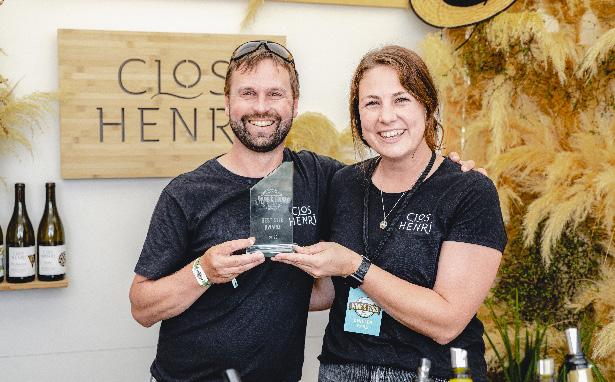
Winning the best site felt “extra special” this year, as the festival was opportunity to unveil Clos Henri’s new labels and logo, to be officially released soon after the event, said Lara. “Releasing these labels first at Marlborough’s own wine and food festival, in front of our peers and interested consumers, was so important for us and we’re very thankful to have had such positive results from it.”
Mud House brand manager Kate Clark says it was great to be sharing their wines with festival goers again and any reservations about creating atmosphere on Renwick Domain were left behind on the day. “Wine Marlborough
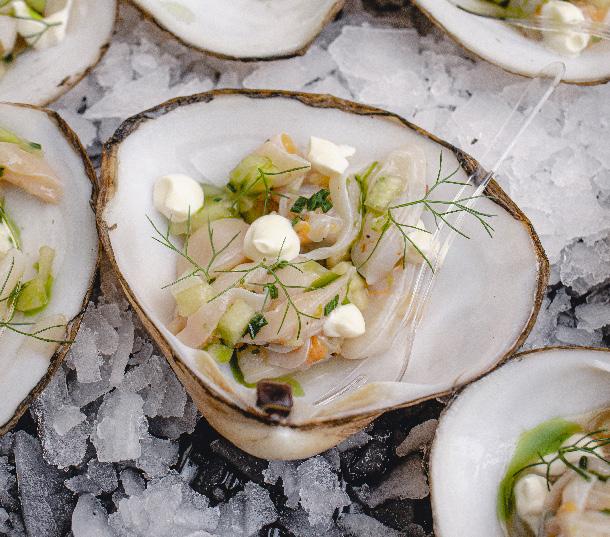
Hydration stations
Liquid Action poured around 2500 litres of water at the 2023 Marlborough Wine & Food Festival, swapping the irrigation of vineyards for the hydration of wine lovers. Owner Matt Broughan says they got involved in the event around a decade ago, when it was just him and his wife Lynne pouring water, along with a few of their employees. But these days they contract it out to community groups raising funds, and the latest festival included around 20 paid volunteers raising money for school rowing teams. “We get involved because we do a significant amount of business with the wineries and vineyards in the Marlborough region, and we want to be the irrigation business that is helping them market their products at this iconic event.”

Winepress March 2023 / 13 CELEBRATE
Cloudy Bay Clams
Damien Yvon and Lara Campbell with Clos Henri
and the event organising team did a fantastic job,” Kate says. “The event had an awesome vibe.” She says the introduction of a cashless event, using the Wayver payment system and wrist bands, was “an absolute breeze to use”.
Meanwhile, attendees could buy mixed cases of wine as they visited winery sites around the festival, by scanning a QR code at participating vendors and adding wines to a Wineway cart, after which the case would be delivered to their home. Katie Cunningham, who founded Wineway in 2021 with a focus on Marlborough wines, said being part of the Marlborough Wine & Food Festival was “an integral part of our mission of supporting our local wineries to deliver their delicious wines to enthusiasts across New Zealand”.
Winemaker Jules Taylor attended the festival as a guest not a supplier and loved the “great feel” of the 2023 event. “Finally we are back together again after a few years of not being able to do this,” she said, cherishing the opportunity catch up with people, “who you usually haven’t seen since the last one, even though you live in the same small town, because people have such busy lives”. And while she had had her “doubts” about the new site, “because I have loved going to Brancott all those years”, organisers had done an amazing job, she added. “It’s been beautiful day.”
Change can be challenging, but “keep an open mind and things come up trumps”, said Marlborough’s Glenn Dick as he and his wife Carina explored the festival on the new Renwick site. “It’s fantastic. The new location has really surprised everybody.”
The festival served up a fantastic experience in an ideal location, said Tracy, surveying its success with a smile. “It’s proved that having an event in the heart of new Zealand’s largest winegrowing region is absolutely a winner.”
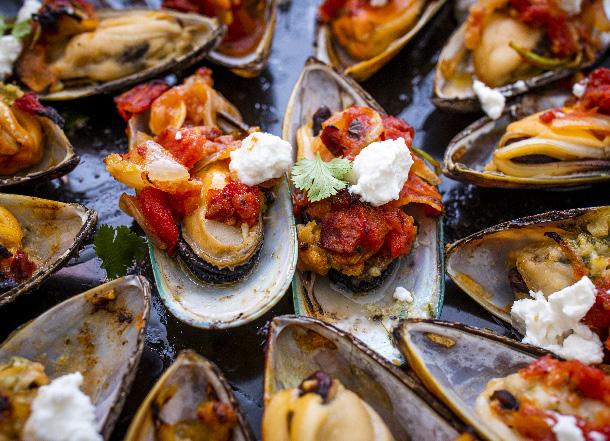
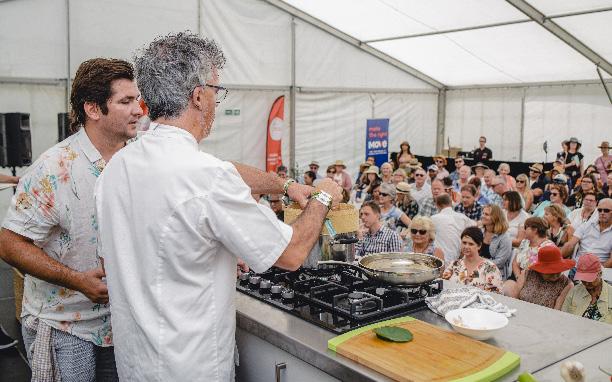
Festival Folk
The Marlborough Wine & Food Festival was a last hurrah for a group of American wine importers visiting New Zealand last month. “It’s the final day of a week of activities and a really lovely way to end,” said Rose Family Estate chief executive Lindsay Parkinson on the day. “They see other people’s products, not just ours, and they see the community come together and have fun.”
Rose Family Estate and Loveblock Wines showed the visitors the Awatere and Wairau Valleys and vineyards, the Wairau River plus Marlborough Sounds, as well as Loveblock’s Queenstown block, with the trip “staged” around the festival on the final day, said Lindsay.


It was a valuable reminder of the value of having people on the ground in Marlborough, rather than getting to know the region via Zoom, he said. “That’s 120% true. When you bring them here, they are not forgetting Marlborough and they are not forgetting us. It blows them away.”
Meeting in person, in the place the wine is made, is incredibly important, he added, noting that the guests were surprised to see some aspects of the region and business, despite being told about them via email and digital meetings. “It’s not until you see it that it sinks in.”
14 / Winepress March 2023 CELEBRATE
Aaron Piper from Cloudy Bay Clams with culinary guest chef Peter Gordon
Mills Bay Mussels in the VIP Retreat
Winemaker Kathrin Jankowiec at the blending masterclass
Emily Bradbury and Hayley Hefford
Wine Marlborough wishes to acknowledge the generous support of the following sponsors




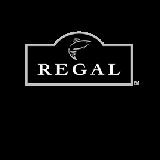





The Marlborough Wine & Food Festival is happy to support the following volunteer groups:


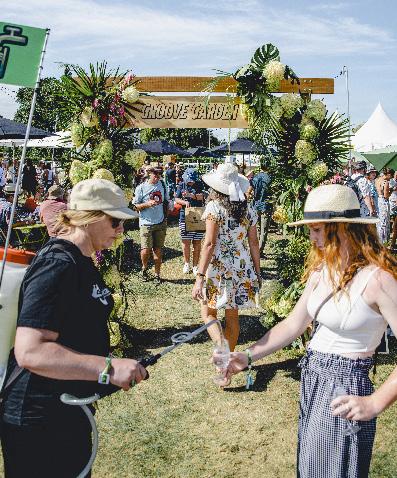




St John, Blenheim South Rotary Club, Blenheim Volunteer Fire Dept, Marlborough Amateur Radio Club, Blenheim Lions, Cancer Society, Springlands Sea Scouts, Whitney Street School, and Blenheim Playcentre



Winepress March 2023 / 15 CELEBRATE
Coterie on the main stage
Photos Richard Briggs
Sweet Mix Kids on the main stage
The Groove Garden
Alice Paterson, Liv Matthews and Jules Taylor
De-Vine Omniscience
As part of a series on entrants in the Cawthron Marlborough Environment Awards, SOPHIE PREECE explores Cropsy’s ‘visionary’ technology.
In 2018 Ali Alomari and Leila Deljkovic began working with artificial intelligence in Ali’s home garage, using machine vision systems to view plants in a whole new light. The work was motivated by the final projects in their computer engineering degrees, which revealed opportunity for scalable technology to improve horticultural performance in New Zealand, along with the appetite for new tech in viticulture.

“We saw an opportunity to leverage our skill set to build something that would solve a lot of the issues that are encountered at scale when you try to apply AI and try to apply machine vision,” says Ali. In 2019 they and another two co-founders - Rory Buchanan and Winston Sulaunched Cropsy Technologies, offering vineyard managers the power of sight, using tractor-mounted sensors and real-time AI to analyse leaf, shoot, cane, buds and bunch, to build a profile of millions of individual plants. Different Cropsy tools are enabled at different times of year, such as spring bud counts or winter cane counts, and the ability to spot powdery mildew and botrytis on vines, viewed individually or through a heat map showing pressure points.
The Cropsy crew call it “omniscience”; Indevin’s Group Technical Viticulturist Rhys Hall calls it “eyes in the field”, welcoming data on individual vines that was too costly and next to impossible to obtain in the past. “I don’t have to be everywhere and down every row.”
Cropsy ’s 2019 launch garnered a grant from AGMARDT, a research and development loan from Callaghan Innovation, and early buy in from Pernod Ricard, which Ali describes as a “visionary” customer that understood what they wanted to do. Last year Cropsy raised $1.5 million in an over-subscribed capital raise, and early this year revealed it would lead a $1.3 million Ministry for Primary Industries’ Sustainable Food and Fibre Futures fund and AGMARDT project to help growers identify and replace grapevines that are missing, dead, dying or otherwise unproductive.
The project - You know I can’t harvest your Ghost Vines: Vineyard-scale monitoring of unproductive vines - will develop tools to help growers understand the health and productivity of every vine in their vineyards in order to identify missing, dead, dying or otherwise unproductive grapevines, says Cropsy’s head of product and innovation
Dr Gareth Hill. “These vines receive all the labour, water, and other vineyard inputs that other vines do without contributing to the overall productivity of the vineyard. For
16 / Winepress March 2023 PROTECT
“Cropsy is all about giving growers the tools to transform growing practices today, but also to overcome the massive challenges of a changing climate in the near future.”
Leila Deljkovic
Ali Alomari and Rory Buchanan getting eyes on the vines
all intents and purposes these vines are either missing or may as well be, which is why we call them ghost vines.”
By measuring and analysing the state of every vine and its neighbours over time, the new project will enable the detection of declining productivity and disease at the earliest possible stage of an outbreak, he adds. “We are building up a ‘patient history’ of all the vines in a vineyard… By putting each vine’s performance into context we’ll be able to make more accurate forecasts about its productivity and the future of the vineyard as a whole.”
The two-year project is a collaboration with Pernod Ricard Winemakers, Indevin Group, and Cloudy Bay Vineyards, along with viticultural consultancy Fantail Consulting. Rhys says the project “will push the boundaries of agritech in New Zealand vineyards”, while Pernod Ricard Winemakers viticulture transformation manager David Allen believes the collaboration offers benefits for the whole industry. “Improving the utilisation of resources such as land and water is something that would benefit the entire industry.”
It’s that increased efficiency of resource use that puts Cropsy in the running for the Cawthron Marlborough Environment awards, says Leila. “Cropsy is all about giving growers the tools to transform growing practices today, but also to overcome the massive challenges of a changing climate in the near future.”
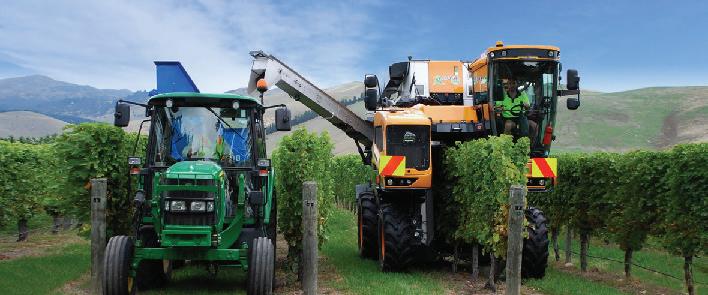
Ali says Cropsy has scanned more than 4.1 million vines since start of 2022, allowing their customers to operate better, with more information for everything from pruning and replanting to pest management and yield assessment. With frequent updates, including ground truthing, the AI is constantly improving. They are also adding to its abilities, and while “dynamic” fungal diseases are currently enabled, they’ll be adding slower developing diseases over time.
“Now that we have the data capture sorted there’s a lot of opportunity to help viticulture improve and evolve into a precision field,” says Ali, seeing a time when there’s no need for guess work. “Almost everything will be backed by data you have collected - down to the single vine, and maybe to the single leaf, one day.”
Cropsy Technologies is one of the entrants in the Business Innovation category of the environment awards, sponsored by Cuddon. cmea.org.nz

Winepress March 2023 / 17 PROTECT
“There’s a lot of opportunity to help viticulture improve and evolve into a precision field.”
Ali Alomari
Upcycling Apparel
Upcycling winery’s waste wardrobe
GIESEN GROUP is rolling out a ‘well-worn’ strategy to reduce its environmental footprint.
Old clothes, personal protective equipment and footwear from the Riverlands winery are being diverted from landfill via trans-Tasman textile recycling and recovery company Upparel. “It’s amazing how many dirty old high vis are hanging around tucked away in corners,” says Giesen Group quality and compliance manager Renee Sturch, excited by the simple step towards circularity.
The project, along with sending gumboots to Bata for recycling, is part of a series of moves towards a lighter waste legacy, says Renee. “We are actively looking to bend that linear directional think to something more circular.” So when she read about Upparel in The Spinoff she immediately got in touch with the organisation, which began in Australia, but expanded to New Zealand in late 2021.
Jeff says over the past two and a half years, across Australia and New Zealand, the organisation has diverted more than 1.2 million kilograms of textile waste from landfill. And since arriving in New Zealand, Upparel has partnered with more than 100 organisations, small businesses, government departments and corporates.
The process was super simple, says Renee, looking forward to getting her first report back on the make-up of the load, including any reduction in CO2 emissions and landfill space as a result of reuse and recycling. She’s hopeful that every shipment will have less in it, as the company works to reduce the turnaround of gear. “The point is really to get as full a life as we possibly can, then at the end of that, to make sure it gets a new lease of life.”
Late last month Giesen was joined by fellow wineries VinLink, WineWorks, Indevin and Villa Maria, along with medical cannabis producer Puro, in sending a load of wellworn waste wear to Auckland, including faded high vis, scuffed steel caps, and piles and piles of unwanted apparel from employees’ homes.

Once there the clothes and boots are sorted into ‘fit for wear’ items that can be reused or recycled through Upparel’s social enterprise program, or unusable items which are repurposed, says Upparel New Zealand director Jeff Vollebregt. In that case, textiles are washed, shredded and transformed into a non-woven felt material and cut to size, laminated or finished with an outer fabric covering. They then become 100% recycled products, such as homewares, furniture and construction items.
It’s an “excellent kick-starter” for a change in attitude and processes, in terms of what is brought in to the company, and how it goes out, says Renee, calling the project a “small yes” in the middle of a big problem of waste. “If you have a small ‘yes’ and change your direction, that tends to snowball into bigger yeses…it’s an effective step to take.”
There’s no such thing as ‘away’, she says of the tradition of landfilling waste. “We are essentially posting our problems to the future.” upparel.com.au
18 / Winepress March 2023 CELEBRATE
SOPHIE PREECE
Lauren Murray, Giesen Group senior cellar supervisor.
“The point is really to get as full a life as we possibly can, then at the end of that, make sure it gets a new lease of life.”
Renee Sturch
Future Post factory to ‘close the loop’ on plastics


Vineyard post manufacturer Future Post expects to have a Blenheim factory in operation by July this year, says national sales account manager Diana Jamieson.
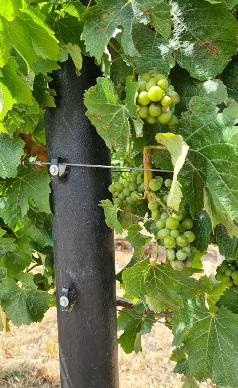
The company’s posts, which are made entirely from recycled plastics and have BioGro certification, have become popular with wine growers for replacement posts and new developments over the past four years, says Diana, who is South Island-based. “As our product reputation and production has grown from the initial start-up phase, it has become very apparent that we needed to include a South Island production line, enabling increased recycling capacity to the whole of the South Island for waste plastics type 2, 4, 5, 6 and 7, as well as reducing freight costs across the Strait and better serving our keen southern clients.” The factory will sit in a new multi-business industrial park at the edge of Blenheim, on the former site of Flight Timber, and will take in thousands of tonnes of South Island waste plastic recycling every
month. It will also allow Marlborough growers and wine makers to “close the loop” on their waste plastics by recycling items such as used vine sleeves, split wine bladders, dripper pipe, buckets, containers into posts for use on vineyard, says Diana. “Should any Future Posts break, they too can be re-recycled onsite and a free replacement provided.” But she’s had no reports of the posts breaking during mechanical harvest, “highlighting the value of these 100% recycled posts for use in a busy sector that is always time poor and would rather focus on producing amazing wines than replacing broken posts”.

Better Biology
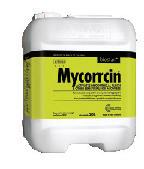
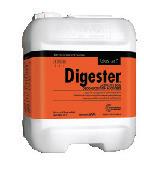
Winepress March 2023 / 19 GROW
Better Wine *Asusedin2021AccoladeWinestrial for provenyieldincreaseandbettertastingwine. Mycorrcin – to boost soil microbes that increase root growth and nutrient uptake Digester – to stimulate decomposition microbes to recycle organic matter fast Foliacin – to improve foliar health and resilience in times of environmental stress Available from leading horticultural suppliers For strong vines, consistent yields and better tasting wines*apply: 0800 116 229 biostart.co.nz
“Should any Future Posts break, they too can be re-recycled onsite and a free replacement provided.”
Diana Jamieson
In the Pipeline
In the second of a series of water updates, resource management expert QUENTIN DAVIES looks at what’s in store for the wine industry.
My previous article (Winepress February 2023) introduced three key points:
(a) Because of the regulation previously imposed by the Marlborough District Council, the Marlborough wine industry is in a good position to navigate the changes to freshwater regulation;
(b) The Marlborough District Council has commenced consultation, most importantly on the values of Marlborough’s freshwater resources; and
(c) Most of the regulation which arises out of that process will have immediate legal effect when it is notified in December 2024 and will completely replace all existing freshwater regulation by 2027.
Underpinning these changes is the National Policy Statement for Freshwater Management 2020. A National Policy Statement directs local government to do what central government directs. While the Marlborough District Council has some leeway as to how it goes about implementing the National Policy Statement, a National Policy Statement must be implemented. This National Policy Statement was accompanied by legislative provisions setting up a special planning process, overseen by a former Environment Court Chief Judge appointed by central government known as the Chief Freshwater Commissioner. A panel (made up of central government appointed commissioners, council representatives, and a representative of tangata whenua) will take what the Marlborough District Council has written in December 2024 and hold hearings on it to ensure that the National Policy Statement has been correctly implemented.
The central concept within the National Policy Statement is Te Mana o te Wai. Te Mana o te Wai, as the policy statement explains, refers to the fundamental importance of water. It recognises that protecting the health of freshwater protects the health and wellbeing of the wider environment. Te Mana o te Wai is about restoring and preserving the balance between water, the wider environment and the community.
Central to the concept of Te Mana o te Wai is a hierarchy of obligations that prioritises:
(a) First, the health and well-being of water bodies and fresh water ecosystems;
(b) Second, the health needs of people (such as drinking water); and
(c) Third, the ability of people and communities to provide for their social, economic and cultural well-being, now and in the future.
Grape growers need to understand that extracting water for irrigation purposes is last in the hierarchy. Irrigation water can only be taken after prioritising the health and well-being of water bodies and freshwater ecosystems.
In order to achieve the intended outcomes of the National Policy Statement, the statement sets out a series of steps must be undertaken by the Marlborough District Council. There is no guarantee that the current regulations will remain after the following steps have been undertaken:
(a) Divide the region up into freshwater management units;
(b) Identify values for each of those units;
(c) Set environmental outcomes for each value and include them as objectives in regional plans;
(d) Identify attributes for each value and identify baseline states for those attributes;
(e) Set target attribute states, environmental flows and levels and other criteria to support the achievement of environmental outcomes; and
(f) Set limits as rules and prepare action plans to achieve environmental outcomes.
There are additional requirements where water is identified as being degraded. Actions need to be taken to bring water back to health.
The measured states of Marlborough’s waters vary from river to river. The council publishes an annual report card and a full State of the Environment Report every three years. Marlborough rivers tend to be sensitive to rainfall. With rainfall comes a substantial deterioration in water quality. Nevertheless, with its low water demand per hectare, low fertiliser use per hectare, and grapes not producing e-coli, the grape industry has made a substantial contribution to at least maintaining, if not improving water quality in Marlborough.
The state of Marlborough’s rivers represents a good starting point to implement Te Mana o te Wai, particularly when compared with some other regions.
One of the central issues is shaping up to be what represents a healthy river. The quality of the water is one factor. Quantity of water, especially at times of low flow, is another.
There are some that say that the quantity of water required for a healthy river can be derived from a formula (often 90% of a natural seven day mean annual low flow). The National Policy Statement does not require the application of any formula. The fact that other councils might adopt that formula in other contexts does not mean that it is necessarily applicable to Marlborough. If it was applied to Marlborough, the ability to take A-class water on the Wairau would need to cease well before 8 cumecs when measured at Barretts Bank. The industry’s scientific advice is to the effect that a present limit of 8 cumecs on
20 / Winepress March 2023 PROTECT
the Wairau adequately preserves the natural values and characteristics of the Wairau River. Indeed, the scientific advice is that if less water was taken for irrigation purposes, the main beneficiary of that would be trout anglers. That is because:
(a) Trout are that much more sensitive to low flows compared to other aquatic organisms; and
(b) Trout tend to consume a wide variety of indigenous species, particularly, insects and other invertebrates which make up our flora and fauna.
Under the current restrictions, the Wairau River boasts what we are told is a nationally significant trout fishery. That is additional justification for the current regulatory limit. These are debates which were held in the Marlborough Environment Plan hearing in 2018. They are versions of the same debate that has been going on in Marlborough for 30 or 40 years.
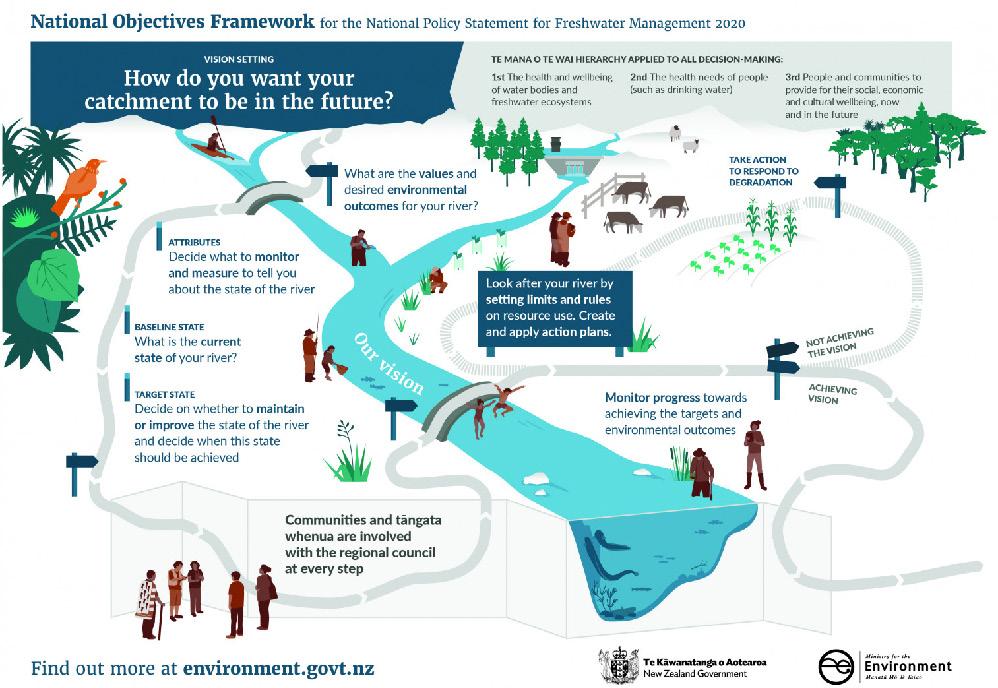
Irrigation is, of course, not the only source of potential changes in water quantities. Afforestation of the head waters of Marlborough’s catchments will reduce the amount
of water flowing into the aquifers and rivers. Climate change models helpfully tell us that Marlborough is likely to be both dryer and wetter, in the form of more prolonged droughts and floods. The National Policy Statement requires us to take a longterm vision which, it suggests, might reasonably be a vision for 30 years. This both enables us to make incremental progress towards our freshwater goals but also requires us to plan for what we can reasonably expect.
As we embark on this process our best arguments are where we demonstrate that Marlborough’s waterways are healthy in the current regulatory regime. Since its foundation, the industry has taken a special interest in preserving and enhancing natural aquatic ecosystems. That, coupled with the inherent low water use and low fertiliser use, means that the grape industry’s development has maintained and enhanced Marlborough’s freshwater values. The Marlborough District Council will soon be seeking to set environmental limits consequent on the values it identifies as part of its consultation process. That consultation is scheduled to commence in September and October 2023.
Quentin Davies is a partner at Gascoigne Wicks and has represented wine industry participants in numerous Court and Council hearings. He will contribute a series of columns outlining regulatory changes on the horizon. The views are his own and are not a substitute for independent legal advice.


Winepress March 2023 / 21 EDUCATE 79 High Street | enquiries@gwlaw.co.nz | www.gascoignewicks.co.nz | T: 03 578 4229
Quentin Davies and Emma Deason have extensive experience in environmental legal matters, and are available to help you with > Resource Consents > Strategic Planning > Understanding resource management law reform
Wicks is a full service law firm, so we can help with all your other personal and business legal matters. Call us now... Proud supporters of the Marine Farming Association
Quentin Davies Emma Deason
Gascoigne
Generation Y-ine
Cameron Steel’s winemaking journey
GROWING UP on the family vineyard, with a strong urge to travel abroad, eventually led Cameron Steel down the winemaking path.
As a youngster, he learned firsthand the art of tending to grapevines when helping out on his parents’ vineyard. Later he soaked up a little more knowledge of winemaking, through his older brother, Marlborough winemaker Phil Steel.
Fresh out of Marlborough Boys’ College he joined the New Zealand Defence Force in 2014, lured by the excitement of international travel and serving overseas. But while he gained some invaluable skills and experience during training, the promise of travel never panned out, so he quit the army and returned to Marlborough to set up his own viticultural management company in 2016.
Through word of mouth, he expanded the business, managing five vineyards while studying a Bachelor in Viticulture and Winemaking Degree through NMIT. “It was full on, between full time study and work, I was doing 16hour days at times,” Cameron says. “I missed a few classes, but my tutors were pretty understanding.”
Having worked three vintages in the vineyard in New Zealand, he decided harvest was the ideal way to satisfy his wanderlust, and in 2017 traveled to the Napa Valley in California where he worked as a vintage cellar hand at Etude Winery and Beaulieu Vineyard. In 2018 he returned to Etude Winery on an internship, which was the beginning of his transition from the vineyard to the winery, he says. “I do really enjoy both sides, and having the viticulture experience has given me a great understanding of how what we do in the vineyard affects the outcome of the wine. But after starting in the winery, I was intrigued by the creativity and the technical side of winemaking.”
In 2019 he traveled to South Australia for vintage work at d’Arenberg Wine and had more plans for work and travel after graduating later that year. But once again those dreams were dashed - this time thanks to the Coronavirus pandemic.

Like many others, Cameron looked for opportunities closer to home, and emailed his CV through to Nautilus Estate, one of a handful of wineries he’d selected purely
because he enjoyed their wines. “I really wanted to work in a winery producing premium wines. Nautilus was the first company I contacted and within an hour and a half of sending the email, I had an interview and was offered a cellar hand role,” he says. “It ended up being an awesome opportunity. I’ve been able to take in a massive amount thanks to the people I’m working with; it’s a huge knowledge resource, right at my fingertips.”
He’s since been promoted to assistant winemaker and works closely with winemakers Clive Jones and Tim Ritchie, and is currently studying a WSET Level 4 Diploma in Wines. “It’s a bit more responsibility, but the best part is being much more involved in the higher end decisions and trials, which is a bit more stressful but more stimulating,” he says.
This year Cameron is ticking off his eleventh vintage and with the world opening up again, along with the responsibilities of his role, he is excited to finally gain some more international winemaking experience, starting with a trip to Burgundy in August.
22 / Winepress March 2023 CELEBRATE
KAT PICKFORD
“I’ve been able to take in a massive amount thanks to the people I’m working with; it’s a huge knowledge resource, right at my fingertips.”
Cameron Steel
SAFETY AROUND LIVE OVERHEAD LINES
Working on a vineyard can put you in all kinds of situationsbut close to electrical equipment and overhead conductors should never be one of them.
Prior to vintage 2018 Marlborough Lines (MLL) undertook a safety campaign to ensure that wine companies, harvest contractors, growers and vineyard owners were aware of the legal requirements for working around live overhead electric lines
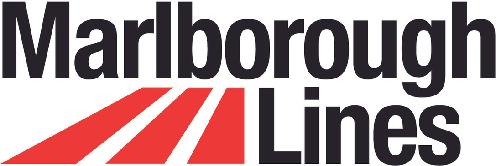
Since then there has been a great response from a wide variety of wine industry participants, and incidents involving mobile plant and overhead lines have thankfully been few in number over that period.
As the network owner, MLL is very mindful of the need to keep "safe working distances" fresh in everybody's minds. While the focus since 2018 has been on the higher risk period over vintage, the requirement extends throughout the year where other vineyard operations are undertaken in the vicinity of overhead lines.
Based on the great response and increased awareness MLL intends to continue with a focus on education, and to encourage a risk-based approach with respect to the operation of mobile plant as a normal part of your hazard assessment for all of your operations.
THE REQUIREMENTS
When mobile plant will be operating (tipping, raising or lowering) 4 metres or less from overhead lines, under section 5 2 1 of NZECP 34 you must apply to MLL for written consent (Close Approach Authority) that allows the mobile plant to operate at a reduced distance.
In other circumstances, when mobile plant is not operating within 4 metres of a live overhead power line, you should identify the risks and apply appropriate controls to prevent harm and/or damage occurring
Get to know NZECP 34 It could save your life
What you need to know - tips to stay safe
Vineyards often have overhead power lines near or running through them, so there is significant risk - to you or your equipment - of accidentally touching the lines. You don't even need to touch the line to be in dangerelectricity can jump through the air to you and your equipment.
Obeying the rules can help ensure all workers' safety
Every line must be treated as live. Always.
Don't locate dump/load sites under or near overhead power lines.
When moving tall machinery, choose the route where power lines are high enough for adequate clearance. Always have any mobile plant device capable of being raised or lowered, in the lowered position prior to moving under lines.

Ensure operators are competent in the operation of their machines, thoroughly briefed and understand the dangers of working near overhead power lines.
Ensure a competent safety observer is able to maintain effective communication with the operator and alert them to any perceived hazard.
Before you harvest, prune, load or move equipment, look up and familiarise yourself with the location of any overhead power lines.
Locate a warning notice as near as practicable to the operator/driver's position stating "WARNING KEEP CLEAR OF POWER LINES". These stickers are available from MLL.
Contact us
If you believe you may require a Close Approach Authority, need warning stickers, or have any questions, please phone Marlborough Lines on 03 577 7007 or email info@mll.co.nz to discuss.
We are happy to provide advice to help ensure everyone remains safe and well when working near overhead lines.
V I N E Y A R D S A F E T Y M A R L B O R O U G H L I N E S
Biosecurity Watch

Biosecurity Tips for Harvest / Vintage 2023

HARVEST IS upon us and now is a good time to ensure you have biosecurity protocols in place in the vineyard and winery to prevent the entry and spread of pests and disease. The New Zealand Winegrowers (NZW) biosecurity team have put together some of the top tips for minimising your vineyard and/or winery’s exposure to biosecurity risk. Keep track of visitor, vehicle and machinery movements:
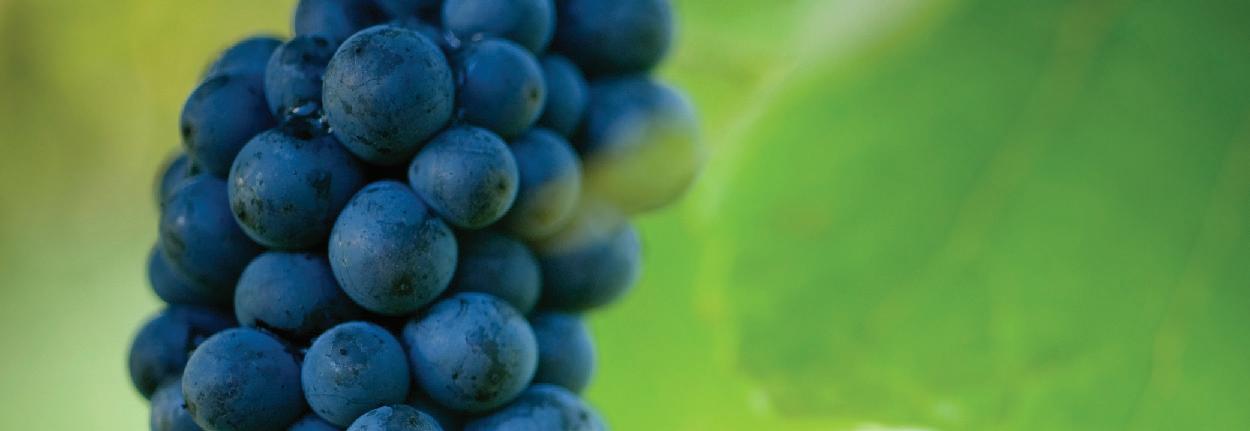
• Ensure there is a robust sign-in process in place to monitor the entry and exit of all visitors and machinery.
• Have a designated parking space for visitors’ vehicles away from the vines and harvest area.
• Minimise vehicle movements around the vineyard as much as possible by using site vehicles (that stay on the property) where available and sticking to regular pathways.
• If using borrowed or contract machinery, keep a record of where it has come from before entering your property, and where it is going next.
Ensure biosecurity signage and reminders are visible:
• Biosecurity signage at entrance gates is a valuable prompt for visitors and contractors to consider the risks they may pose before they enter your property.
• Biosecurity and vineyard hygiene practices in site inductions also helps to keep them front of mind for visitors.
• Washdown areas for machinery, tools, equipment and footwear are clearly sign posted.



• Vineyard biosecurity signage is available online from sites such as thesignmaker.co.nz

Wash down harvest machinery, vehicles, and equipment as much as possible
• Check contractor equipment for cleanliness before allowing entry to your vineyard.
• Equipment and machinery covered in soil and plant material can spread pests like mealybug and weed seeds like Chilean needle grass very easily between sites.
• If practicable, provide cleaning and washdown facilities with high pressure air or water for dirty equipment; redirect to an offsite cleaning facility; or if necessary, refuse entry until the equipment has been cleaned. While this may be painful or seem inefficient in the shortterm the measures above could save thousand in pest or disease management costs in the long run.
Thoroughly inspect newly imported machinery and equipment
• If you’re importing vineyard or winery equipment from overseas, new or used, ensure you thoroughly check when it arrives on site.
• While pre-border and border precautions should take care of most biosecurity risk, no system is perfect, so stay vigilant for the presence of unwanted pests or contaminants when receiving your goods:
• Open them up in an enclosed room, shed or garage.
• Check all compartments and inspect the packaging.
• Some pests (such as the brown marmorated stink bug) are excellent hitchhikers and can easily be transported on goods normally considered low risk.
• If the machinery is used or second-hand, ensure it is clean and there are no visible contaminants such as soil or plant material.
If you see anything suspicious, catch it, take a photo, and call the Biosecurity NZ hotline on 0800 80 99 66.

Watch out for harlequin ladybird
The harlequin ladybird is a potential wine industry pest which can now be found in New Zealand’s wine regions, including Central Otago. As temperatures start to drop at the end of summer, harlequin ladybirds start to search for
24 / Winepress March 2023 PROTECT
IF YOU SEE ANYTHING UNUSUAL CATCH IT. SNAP IT. REPORT IT. CALL THE BIOSECURITY NEW ZEALAND PEST AND DISEASE HOTLINE 0800 80 99 66 Email enquiries to biosecurity@nzwine.com
KERRIE HOPKINS
overwintering sites and will aggregate together in large groups. Overseas (in Canada and the USA), they have been known to aggregate inside grape bunches prior to harvest, although this behaviour hasn’t yet been observed in New Zealand. When harlequin ladybirds become startled, they release methoxypyrazines designed to deter predators, and unfortunately, these chemicals can cause ‘ladybird taint’ in affected wine. New Zealand Winegrowers recommends growers who have noticed the presence of harlequin ladybird in or around their vineyards undertake surveillance prior to harvest to ensure they are not clustering inside grape bunches. If you do find them inside bunches, get in contact with the NZW biosecurity team (biosecurity@ nzwine.com)
Keep an eye out for garden weevil
The Bragato Research Institute (BRI) extension team and the NZW biosecurity team have been working with growers this season to monitor garden weevil (Phylictinus callosus) presence in vineyards around Marlborough. The garden weevil has been present in New Zealand for many years, but
recent reports indicate damage caused to grapevines by this insect has been increasing, and in some instances is nearing an economic threshold where control measures need to be considered. Some vineyards report weevil issues at harvest, with the insects crawling out of picking bins in large numbers (where fruit is hand-picked). If you think you have found weevils or weevil damage in your fruit, or are seeing them in the vines, please take a photograph and contact kerrie.hopkins@nzwine.com, or submit the photograph via the Find-a-Pest app from a smartphone.
Remain vigilant and report anything unusual or suspicious:

At this time of year, staff in vineyards are actively monitoring the ripeness of grapes, walking the rows or driving around in a tractor or harvester and looking at bunches and vine canopy. This is a great opportunity to do a quick check for any unusual or exotic pest and disease symptoms. Ensure staff know what to do if they see anything unusual – Catch It, Snap It, and Report It to the Biosecurity NZ hotline on 0800 80 99 66 and get in touch with the NZ Winegrowers biosecurity team . (biosecurity@nzwine.com)
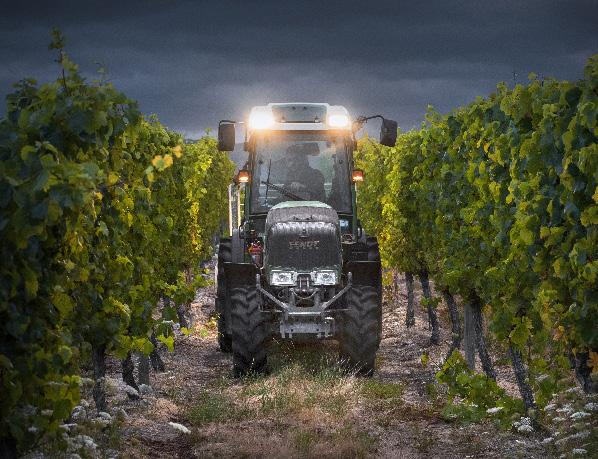
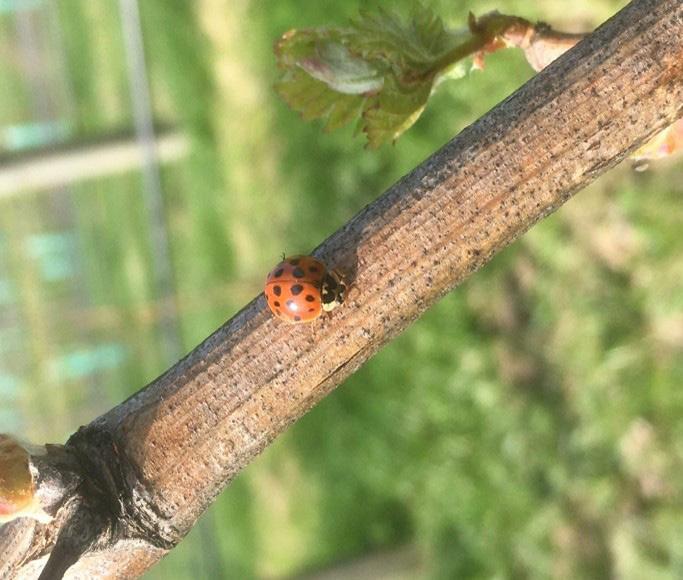
Winepress March 2023 / 25 GROW
The invasive harlequin ladybird is now widespread in New Zealand after first being discovered here in 2016.
Industry News
Renwick cycle trail
The second stage in Renwick’s vineyard cycle trail is underway, with a 6.5km section linking Allan Scott winery on Jacksons Road to Renwick, using off-road routes. That’s part of a proposed 8.7km trail to connect with an existing section of off-road path along Jacksons Road, which was completed in 2020. Marlborough Mayor Nadine Taylor says the trail is a significant addition to the existing cycle infrastructure around Renwick, and important for tourism. “I would particularly like to acknowledge the support of corporate landowners who have given easements through their properties,” she says. “It’s fantastic to get visitors and locals off busy roads and cycling through the vines.”
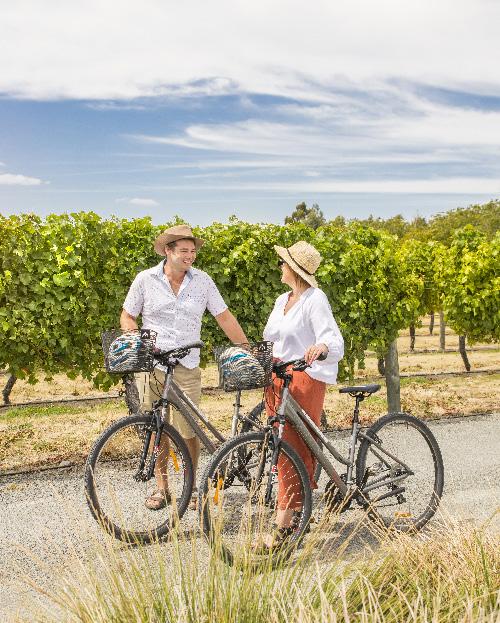
There are 20 cellar doors within an 8km radius of Renwick and 10,000 bike visitors each year. Steve Hill, chairman of the Renwick Bike Walk group, said the trail goes along the Ōpaoa River stop bank and joins up with the Omaka River near the Old Renwick Road ford, following that to the SH63 road bridge, then along road reserve to Havelock Street. Future plans include completing an entire trail around Renwick that will benefit locals as well as tourists. “There are areas on the edges of vineyards, on river stop banks and roadside reserves that, with careful development and management, can be used for cycle paths with minimal or no impact on vineyard operations,” Steve says. “The wineries we have worked with so far have recognised this potential and their involvement has been a major boost to the paths we’ve developed.”
Steve thanked property owners for their generosity and cooperation including Talley’s, Pernod Ricard, Wither Hills, Allan Scott Family winemakers, Peter Jackson Vineyards and the Jordon Geddes Trust.
Advocacy update NICCI ARMOUR
The Labour government has introduced several significant reforms in the last two to three years. And while many people may support the need or aspirations of the reforms, the number of reforms, the pace at which they have been instigated, and the communication of the reforms have contributed to gaps in information and engagement for many of us on the ground.
When it comes to government policy and reform, our industry’s position is typically represented by New Zealand Winegrowers (NZW) via the advocacy team or, where applicable, the environment team. NZW work closely with government on key matters for the wine industry; they make submissions on behalf of the wine industry, and present at Select Committees where needed. However, many of the recent reforms have a regional impact, and more and more often there is cross-over between national and regional considerations.
Wine Marlborough recently submitted on the introduction of the Natural and Built Environments Act (NBA), which is part of the Resource Management Act (RMA) reform. Our submission wholly supported that of NZW, but also emphasised specific regional considerations including i) that the region’s water health does not require the level of urgent intervention that may be justified in other regions, ii) the impact of blanket resource consent provisions creating unnecessary cost, diverting resources, and disincentivising additional investment and job creation, and iii) our support for the policy decision taken in the Bill not to combine Marlborough with Nelson and Tasman as a single unified regional for planning purposes. To receive a copy of the full submission, please email advocacy@winemarlborough.nz. NZW have section on their website for Government Consultations and Submissions.
The Marlborough District Council are currently embarking on a process to support and plan for the region’s freshwater management (note this is separate to the Three Waters reform). This process was initiated through the National Policy Statement for Freshwater Management 2020 (NPSFM 2020). This is a government policy that gives local authorities direction on how to manage freshwater under the RMA; the NPSFM 2020 is expected to fall under the NBA when it is finalised. In Marlborough we have three engagement phases with council between now and 2024, and it is imperative that our wine industry members participate in this process as both members of the community and local businesses. To find out more, reach out to advocacy@winemarlborough.nz or share your views directly by emailing freshwater@marlborough.govt. nz. See page 20 for more on this process.
Nicci Armour
is
Wine Marlborough advocacy manager.
26 / Winepress March 2023
Coastal cleaners
A Babich Wines beach clean-up yielded 332kg of trash from the Wairau Bar in January, including a bicycle, tent and washing machine, along with an inundation of plastics and broken glass. The trash collected by 32 staff in one day, from corrugated iron to a barbecue grill, was “eye-opening” for the group, says David Bullivant, Babich Wines Marlborough area viticultural manager.


“The exercise reinforced our suspicion that small and large amounts of plastic and rubbish that pollute our properties and communities, far from the ocean, end up in the ocean and on our foreshores. Every single day we handle items from plastic bags to writing pens and these items are often subconsciously discarded on the street, but they don’t break down and rain, drains and streams transport them to the sea,” he says. “On Friday I also asked myself, ‘why does someone drive all the way to the Wairau Bar to dispose their old washing machine, or bicycle or car tyres?’ It is very important that financial reasons do not prevent people from taking rubbish like old washing machines and daily household waste to the council refuse station.”
The work is part of Babich Wines’ sponsorship of the Sustainable Coastlines Charitable Trust, with water quality and ocean pollution becoming two of New Zealand’s biggest issues, says Babich chief executive David Babich. “For us, sponsoring Sustainable Coastlines and supporting communities to clean-up and prevent litter pollution on our beaches is just as important as what we do in our family’s vineyards.”
Organic & Biodynamic Winegrowing Conference

Sound of Summer
CHERIE AGNEW
Strong winds didn’t stop festival goers grooving, vinyl beats blearing, or sun hats sailing across the Sound of White vineyard at this year’s Catalina Sounds Sound of Summer. The Waihopai Valley festival is in its second year, as a collaboration between Catalina Sounds and the Vinyl in the Vines Marlborough DJ collective. Putting it on is “a hell of a lot of work”, but it’s “an incredible site”, says Catalina Sounds winemaker Matthew Ward. “It needs to be shared with people. And because of the style of wines that I’m making, I wanted to bring food into the element.”
Having previously worked as a sommelier at Michelin starred restaurant Chez Bruce in London, Matt’s passion for creating food savvy wines shines through. There was plenty of quality kai to pair with the wine on the day, with Cloudy Bay Clams, Boom Chef and La Ruca catering for diverse tastes.
To quench all thirst needs, Roots Gin and Boom Town beer were available alongside wines from Catalina Sounds and Lawson’s Dry Hills. “Quality is the driver of everything that we do,” says Matt, with that philosophy traversing the festival, including in the crisp white tablecloths adorning communal tables.
With Covid restrictions in the rear-view mirror, the friendly atmosphere of the Catalina Sounds Vinyl in the Vines is a great reminder to share in the enjoyment of the quality food, beverages and music that Marlborough has to offer.
The Organic & Biodynamic Winegrowing Conference will be held from 20-22 June this year, centred around Matariki and the winter solstice.
Since its inception in 2015, the biennial, three-day organic “immersion” has gone from strength to strength, says Greystone viticulturist and conference committee member Mike Saunders. This year’s conference – held after a Covid-19 hiatus - has a strong line up of speakers from across the globe including Dr Andrew Smith from the Rodale Institute and Elaine Chukan Brown, aka Hawk Wakawaka.
Themes for this year’s event will build on the three key pillars: of Create, Care and Connect. “The conference will create conversation around new research, different growing systems, and improved technology,” says Mike. “It will promote the care for our land and environment by providing practical ways of protecting and enhancing our soil, water, and plant resources. And it will connect people with their land, history, culture, and to other growers around them, forming the same symbiotic relationships our plants, soil, fungi and bacteria thrive on.” Tickets are for sale at organicwineconference.com
Winepress March 2023 / 27
Nicole Walsh stirring the biodynamic preparation 500 at Churton
Babich beach clean
Wine Happenings
A monthly list of events within the New Zealand wine industry.


To have your event included in the April Wine Happenings, please email details to sophie@sophiepreece.co.nz by March 20. For more information, please use the contact supplied or email sarah@winemarlborough.nz

MARCH
3 Framingham Wines 2023 Harvest Concert (R18), 6pm to 11pm (marlboroughnz.com)
4 Vinyl in the Vines, The Vines Village, 12pm to 5pm (marlboroughnz.com)

5 Forrest Estate Summer Sunday Sessions, 1pm to 4pm until April 23, 2023 (marlboroughnz.com)
8 International Women’s Day (internationalwomensday.com)
8 Rock Ferry Wine’s Twilight Market, 4pm to 7pm
12 Awatere Wine Tasting Summer Series Tūpari Cellar Door, 12.30 to 1.30
19 - 21 Prowein, Dusseldorf

APRIL
7 - 9 2023 Yealands Classic Fighters Airshow (classicfighters.co.nz)
20 2023 Cawthron Marlborough Environment Awards event, 5pm, Marlborough Events Centre

MAY


13 Saint Clair Vineyard Half Marathon (vineyardhalf.com)
JUNE
20 - 22 Organic and Biodynamic Winegrowers Conference (organicwinenz.com)
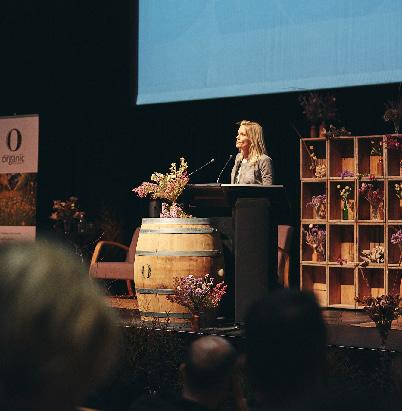

28 / Winepress March 2023
2023 Harvest Concert - March 3 Environment Awards - April 20
Organic Conference - June 20-22
CROPLANDS SALES AND SERVICE AGENT FOR THE MARLBOROUGH REGION

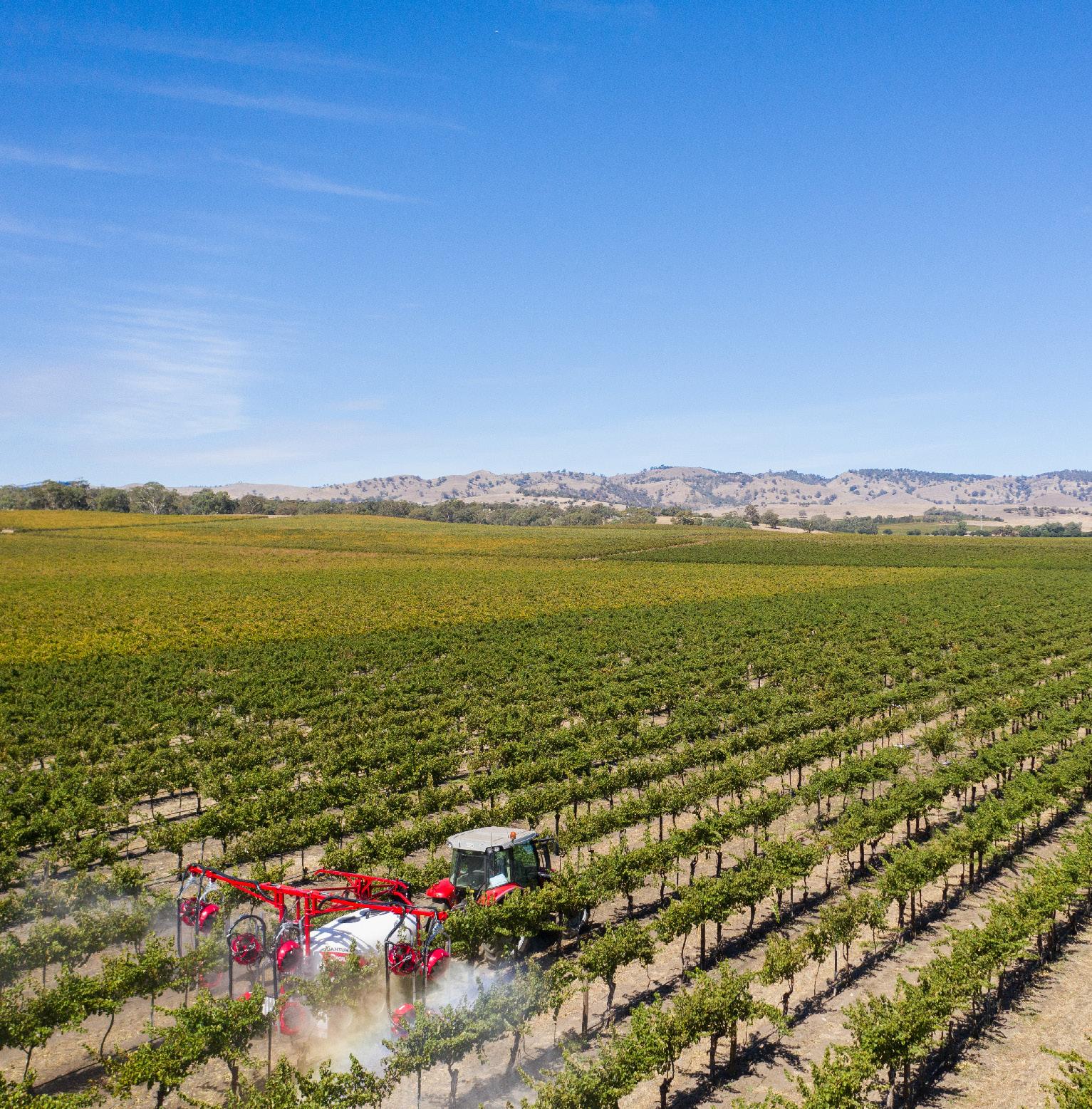
Selling, building and servicing Croplands Quantum Vineyard Sprayers
Now building, servicing and selling Croplands Quantum Vineyard Sprayers
Now building, servicing and selling Croplands Quantum Vineyard Sprayers
For more information or to order your next Quantum Vineyard Sprayer. Contact the crop protection specialists at Agrivit.
Now building, servicing and selling Croplands Quantum Vineyard Sprayers
For more information or to order your next Quantum Vineyard Sprayer, contact the Malborough’s Spray Equipment Specialists at Agrivit.
For more information or to order your next Quantum Vineyard Sprayer, contact the Malborough’s Spray Equipment Specialists at Agrivit.
For more information or to order your next Quantum Vineyard Sprayer, contact the Malborough’s Spray Equipment Specialists at Agrivit.
Jeremy Watts | 021 446 225 | jeremy@agrivit.co.nz | 03 572 8787 | www.agrivit.co.nz
Jeremy Watts | 021 446 225 | jeremy@agrivit.co.nz | 03 572 8787 | www.agrivit.co.nz
Jeremy Watts | 021 446 225 | jeremy@agrivit.co.nz | 03 572 8787 | www.agrivit.co.nz
SOLD LOCALLY BUILT LOCALLY SERVICED LOCALLY
SOLD LOCALLY BUILT LOCALLY SERVICED LOCALLY
Jeremy Watts | 021 446 225
SOLD LOCALLY BUILT LOCALLY SERVICED LOCALLY
jeremy@agrivit.co.nz
03 572 8787 | www.agrivit.co.nz
Agent
the Marlborough
Croplands Sales and Service
for
Region
CLD6791_Croplands NZ agrivit ad_297x210mm.indd 1 24/11/22 1:02 pm
Sales and Service Agent for the Marlborough
Croplands
Region
Croplands Sales and Service Agent for the Marlborough Region
Post-harvest nutrition
Replenish the vines with nutrients in preparation of bud break in spring. With a focus on delivering nitrogen, potassium, boron and zinc to the plants, our Technical Horticultural Representatives will o er advice and product solutions to help you produce quality fruit in the coming season.

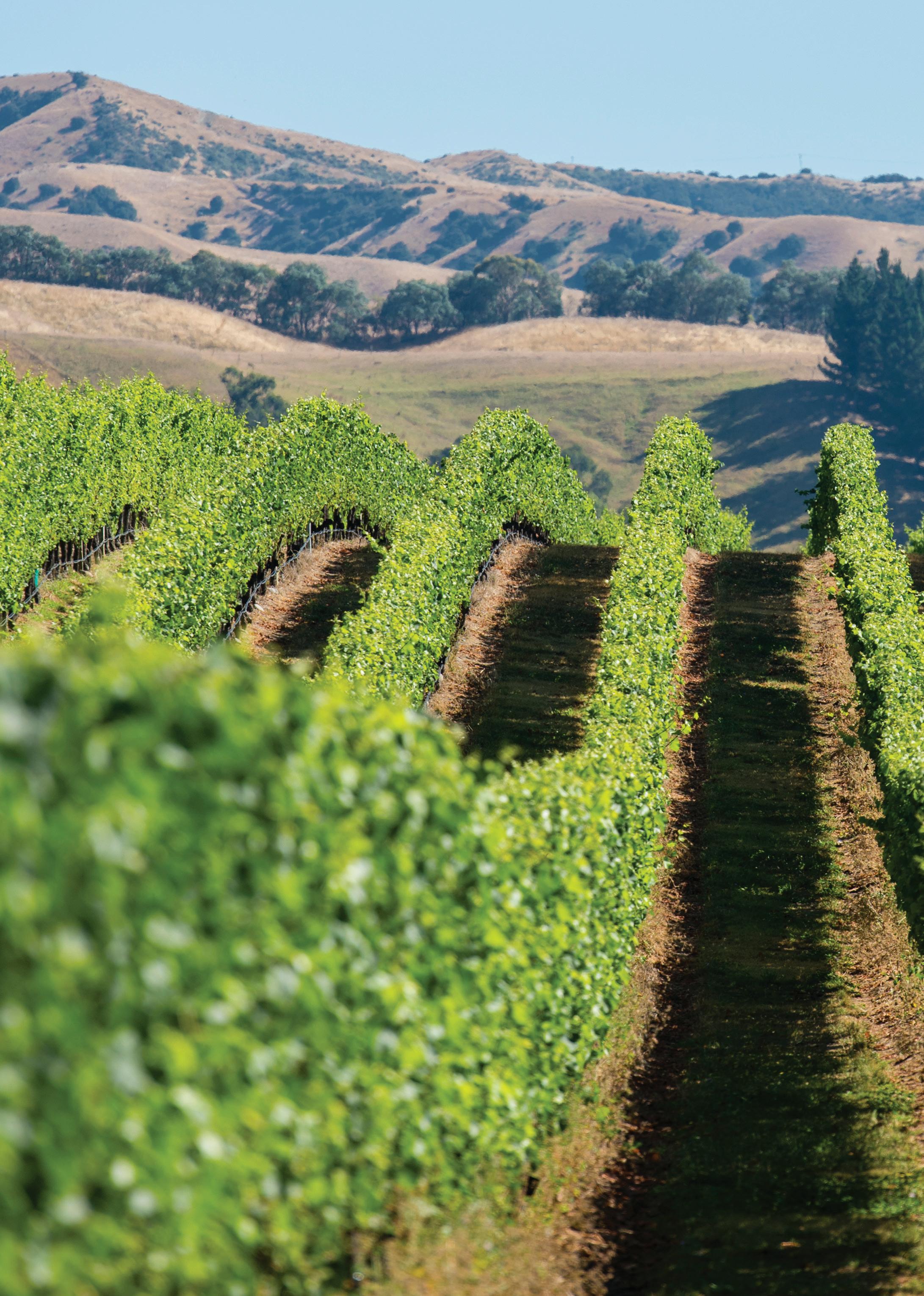
We know horticulture

www.fruitfedsupplies.co.nz


A trading division of PGG Wrightson Ltd
team, or visit fruitfedsupplies.co.nz for
Contact your local Fruitfed Supplies
more information.






























































































